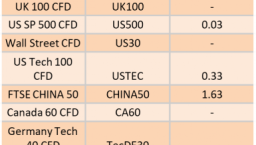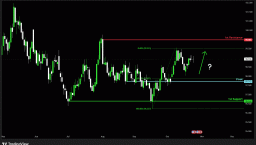Articles
Ex-Dividend 29/10/2025
422850 October 29, 2025 18:06 ICMarkets Market News

The post Ex-Dividend 29/10/2025 first appeared on IC Markets | Official Blog.
Wednesday 29th October 2025: Technical Outlook and Review
422834 October 29, 2025 18:05 ICMarkets Market News
DXY (U.S. Dollar Index):
Potential Direction: Bullish
Overall momentum of the chart: Bearish
The price is falling toward the pivot and could make a short-term pullback toward this level before rising again toward the 1st resistance.
Pivot: 98.55
Supporting reasons: Identified as a pullback support that aligns closely with the 50% Fibonacci retracement, indicating a potential area where buying interest could pick up
1st support: 98.00
Supporting reasons: Identified as an overlap support, indicating a potential area where the price could again stabilize.
1st resistance: 99.53
Supporting reasons: Identified as an overlap resistance, indicating a potential area that could halt any further upward movement
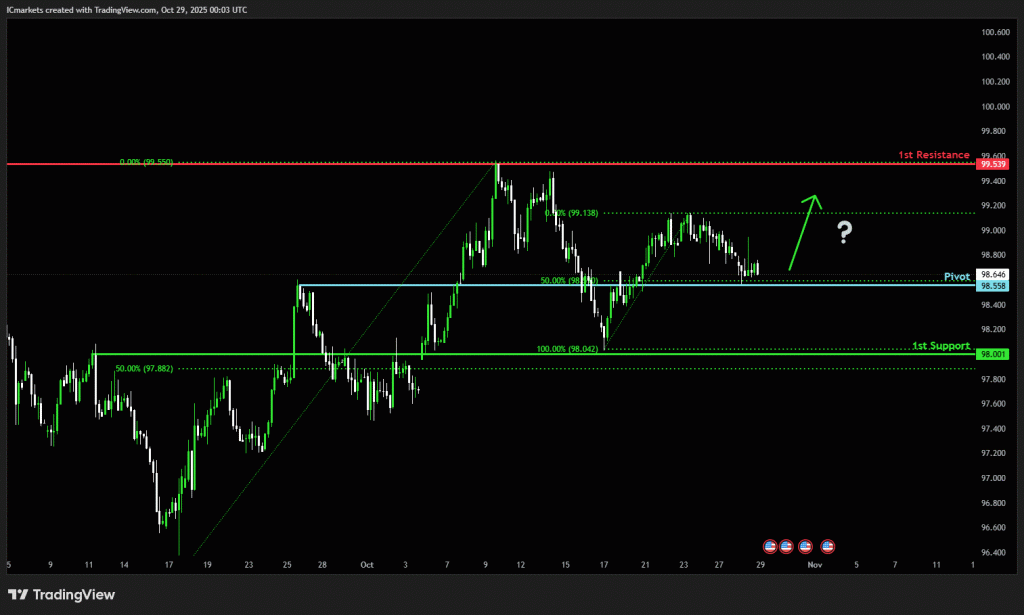
EUR/USD:
Potential Direction: Bullish
Overall momentum of the chart: Bullish
The price has already bounced off the pivot and may continue its bullish move toward the 1st resistance
Pivot: 1.1620
Supporting reasons: Identified as an overlap support, where renewed buying pressure could emerge to push the price higher.
1st support: 1.1590
Supporting reasons: Identified as an overlap support, indicating a potential level where the price could stabilize once again.
1st resistance: 1.1666
Supporting reasons: Identified as a pullback resistance that aligns closely with the 61.8% Fibonacci retracement, indicating a potential level that could cap further upward movement.
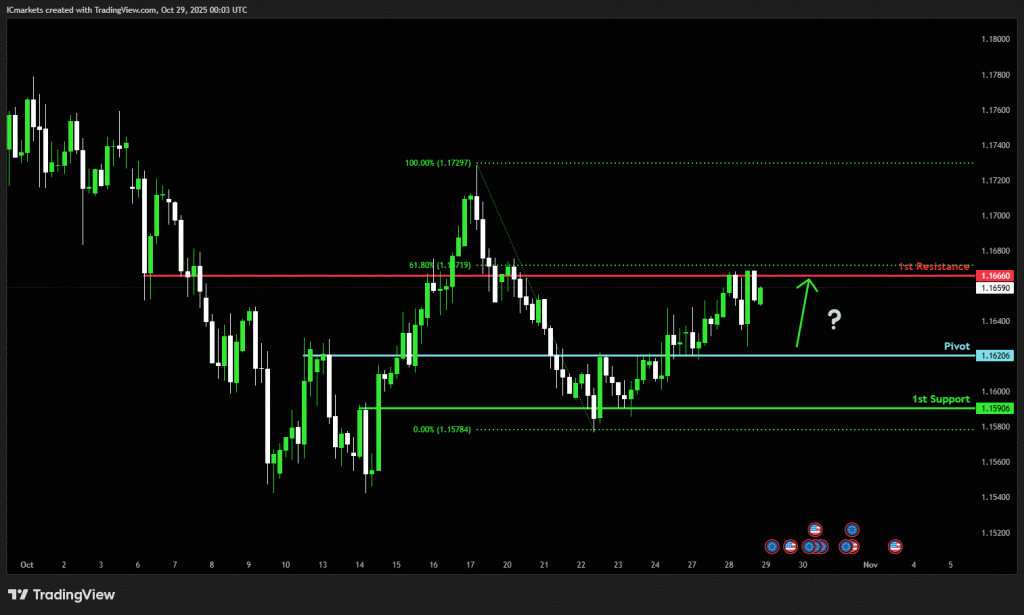
EUR/JPY:
Potential Direction: Bearish
Overall momentum of the chart: Bullish
The price has already reacted off the pivot and may continue its bearish move toward the 1st support
Pivot: 177.75
Supporting reasons: Identified as a swing high resistance, where selling pressures could intensify and potentially cap any upward retracement
1st support: 174.92
Supporting reasons: Identified as an overlap support, indicating a potential area where the price could again stabilize.
1st resistance: 179.80
Supporting reasons: Identified as a resistance that is supported by the 161.8% Fibonacci extension, indicating a potential level that could cap further upward movement.
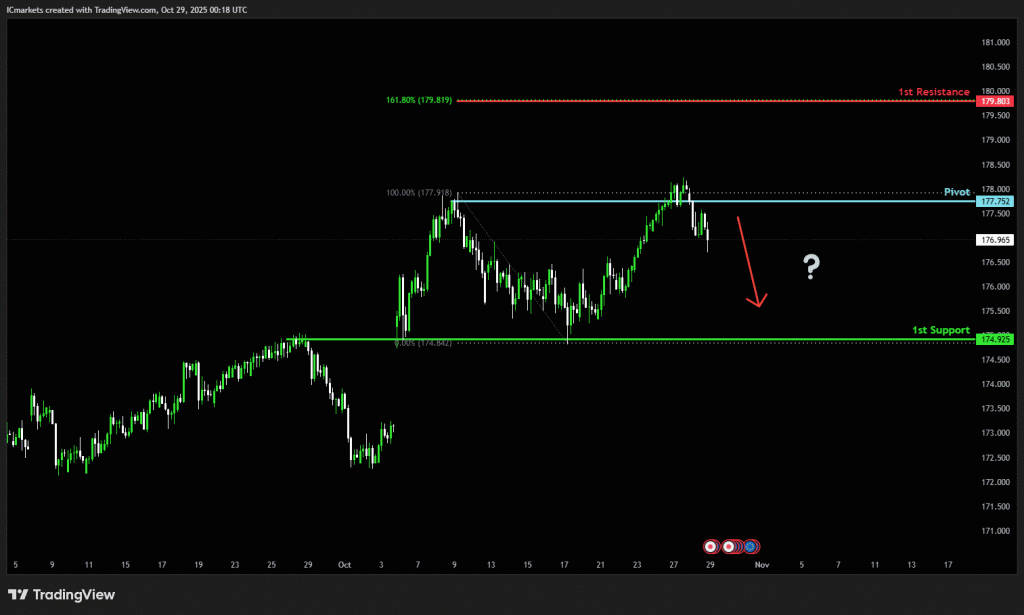
EUR/GBP:
Potential Direction: Bullish
Overall momentum of the chart: Bullish
The price could fall toward the pivot and could make a short-term pullback toward this level before rising again toward the 1st resistance.
Pivot: 0.8749
Supporting reasons: Identified as a pullback support, where renewed buying pressure could emerge to push the price higher.
1st support: 0.8718
Supporting reasons: Identified as overlap support, indicating a potential area where the price could stabilize once more.
1st resistance: 0.8809
Supporting reasons: Identified as a resistance that is supported by the 161.8% Fibonacci extension, indicating a potential level that could cap further upward movement.
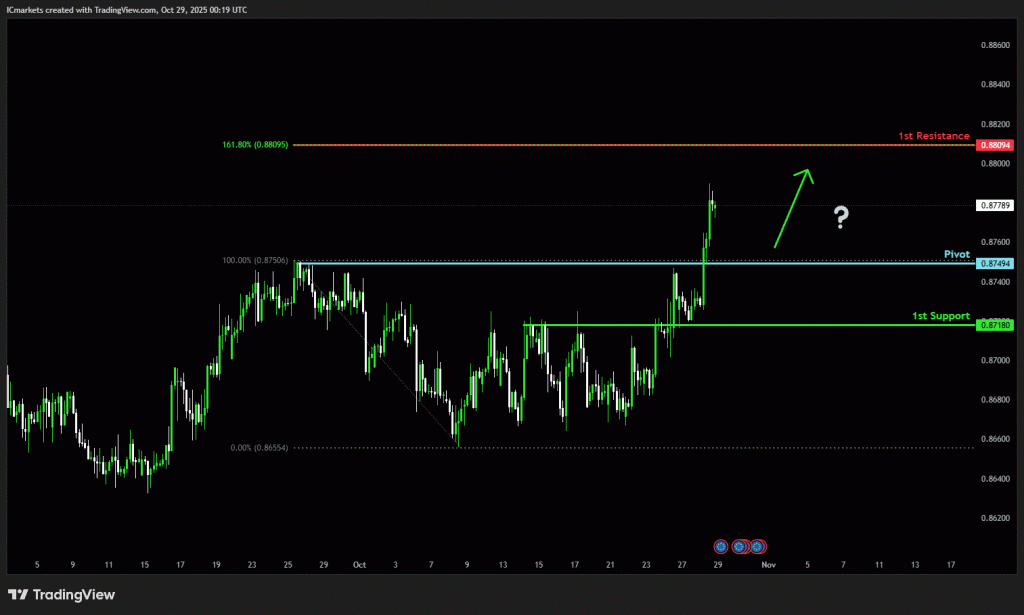
GBP/USD:
Potential Direction: Bearish
Overall momentum of the chart: Bullish
The price could see a short-term pullback toward the pivot before continuing its bearish move down toward the 1st support.
Pivot: 1.3332
Supporting reasons: Identified as a pullback resistance, where selling pressures could intensify and potentially cap any upward retracement.
1st support: 1.3248
Supporting reasons: Identified as a swing low support, indicating a potential area where the price could stabilize once more.
1st resistance: 1.3409
Supporting reasons: Identified as an overlap resistance, indicating a potential level that could halt further upward movement.
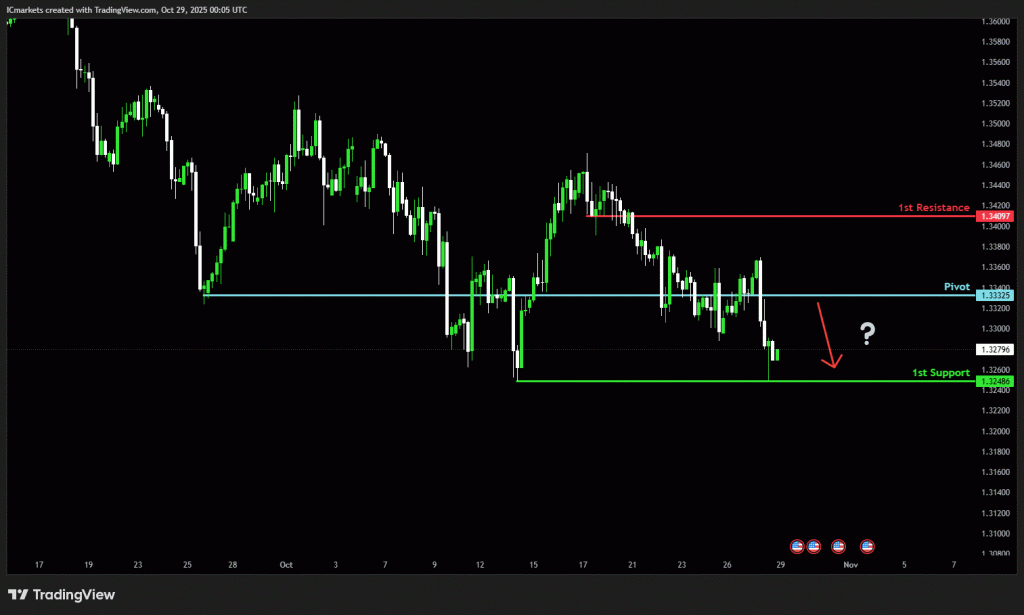
GBP/JPY:
Potential Direction: Bearish
Overall momentum of the chart: Bullish
The price could rise toward the pivot and make a short-term pullback toward this level before continuing its bearish move down toward the 1st support.
Pivot: 202.74
Supporting reasons: Identified as a pullback resistance, where selling pressures could intensify and potentially cap any upward retracement.
1st support: 200.47
Supporting reasons: Identified as a pullback support, indicating a potential level where the price could stabilize once more.
1st resistance: 204.03
Supporting reasons: Identified as a swing high resistance, indicating a potential level that could halt further upward movement.
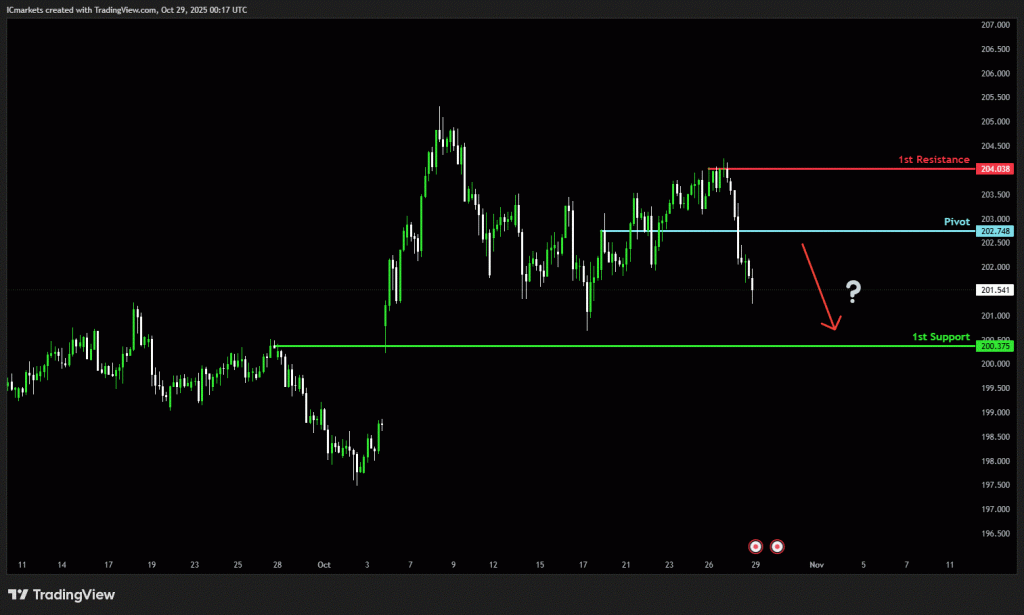
USD/CHF:
Potential Direction: Bullish
Overall momentum of the chart: Bearish
The price is falling toward the pivot and could make a short-term pullback toward this level before rising again toward the 1st resistance.
Pivot: 0.7921
Supporting reasons: Identified as an overlap support that aligns with the 61.8% Fibonacci retracement, where renewed buying pressure could emerge to push the price higher.
1st support: 0.7874
Supporting reasons: Identified as a swing low support, indicating a potential level where the price could stabilize once again.
1st resistance: 0.7996
Supporting reasons: Identified as an overlap resistance that aligns with the 61.8% Fibonacci retracement, indicating a potential level that could cap further upward movement.
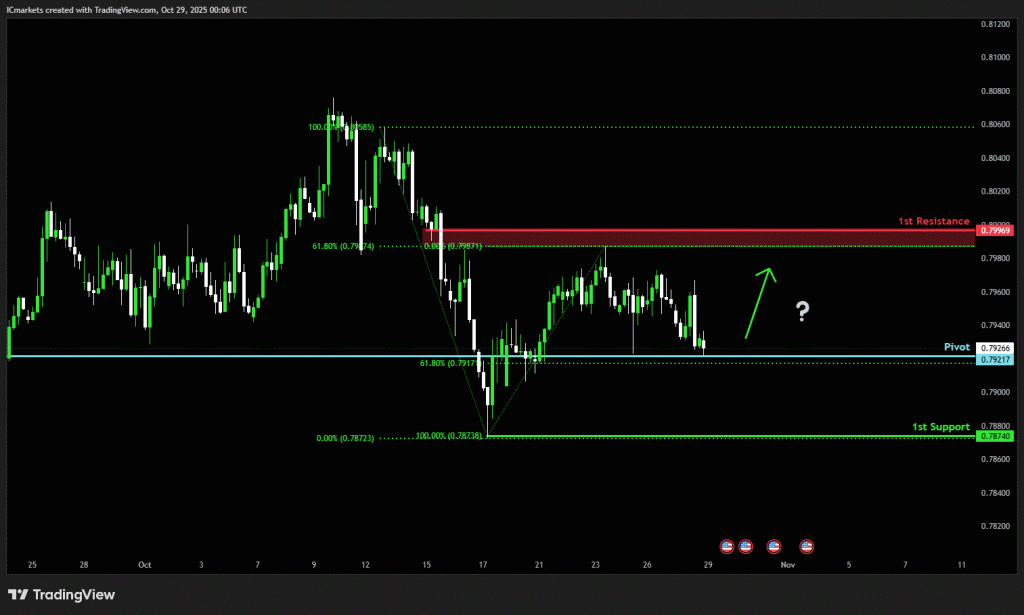
USD/JPY:
Potential Direction: Bearish
Overall momentum of the chart: Bullish
The price could see a short-term pullback toward the pivot before continuing its bearish move down toward the 1st support.
Pivot: 151.84
Supporting reasons: Identified as a pullback resistance, where selling pressures could intensify and potentially cap any upward retracement.
1st support: 149.87
Supporting reasons: Identified as an overlap support that aligns with the 50% Fibonacci retracement, indicating a strong area where buyers might return, and the price could stabilize once again.
1st resistance: 153.25
Supporting reasons: Identified as a swing high resistance. This level represents the next key area where upward movement could be capped amid increased selling pressure
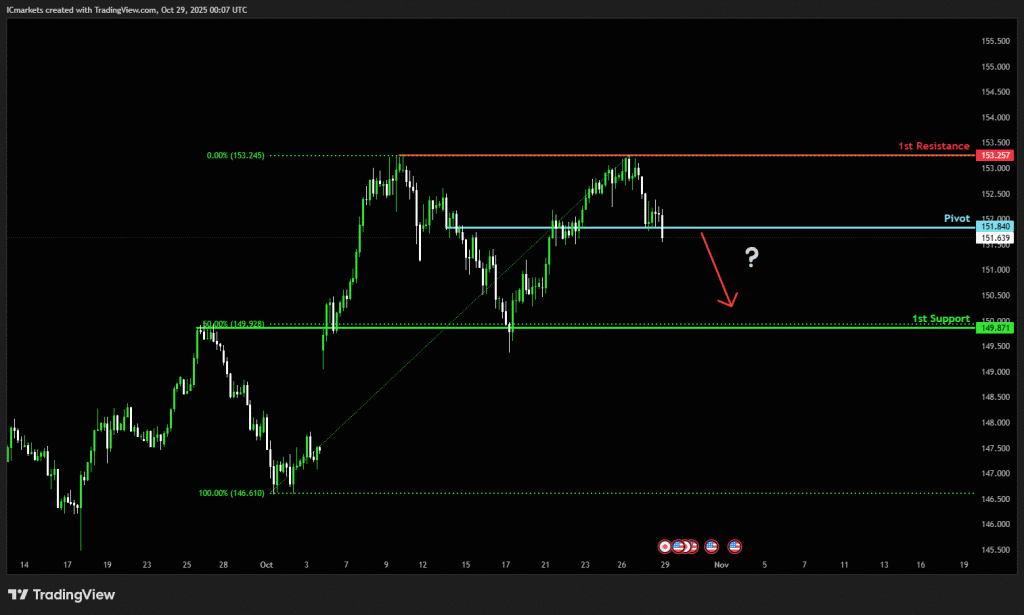
USD/CAD:
Potential Direction: Bearish
Overall momentum of the chart: Bearish
The price could see a short-term pullback toward the pivot before continuing its bearish move down toward the 1st support.
Pivot: 1.3978
Supporting reasons: Identified as a pullback resistance, where selling pressures could intensify and potentially cap any upward retracement.
1st support: 1.3907
Supporting reasons: Identified as an overlap support that aligns with the 50% Fibonacci retracement, indicating a key level where the price could stabilize once more.
1st resistance: 1.4029
Supporting reasons: Identified as an overlap resistance, making it a possible target for bullish advances and a level where some sellers could return to cap gains
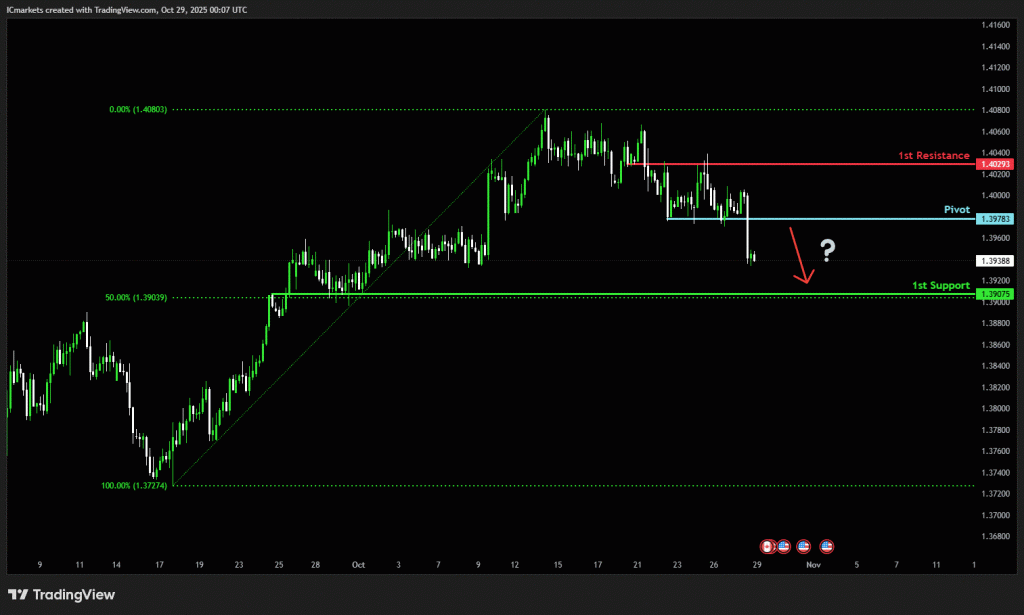
AUD/USD:
Potential Direction: Bullish
Overall momentum of the chart: Bullish
The price could make a short-term pullback toward the pivot before rising again toward the 1st resistance
Pivot: 0.6524
Supporting reasons: Identified as a pullback support, where renewed buying pressure could emerge to push the price higher.
1st support: 0.6484
Supporting reasons: Identified as a swing low support, this area has provided strong support historically and may attract buying interest for a potential short-term bounce
1st resistance: 0.6590
Supporting reasons: Identified as an overlap resistance, indicating a potential area that could halt any further upward movement.
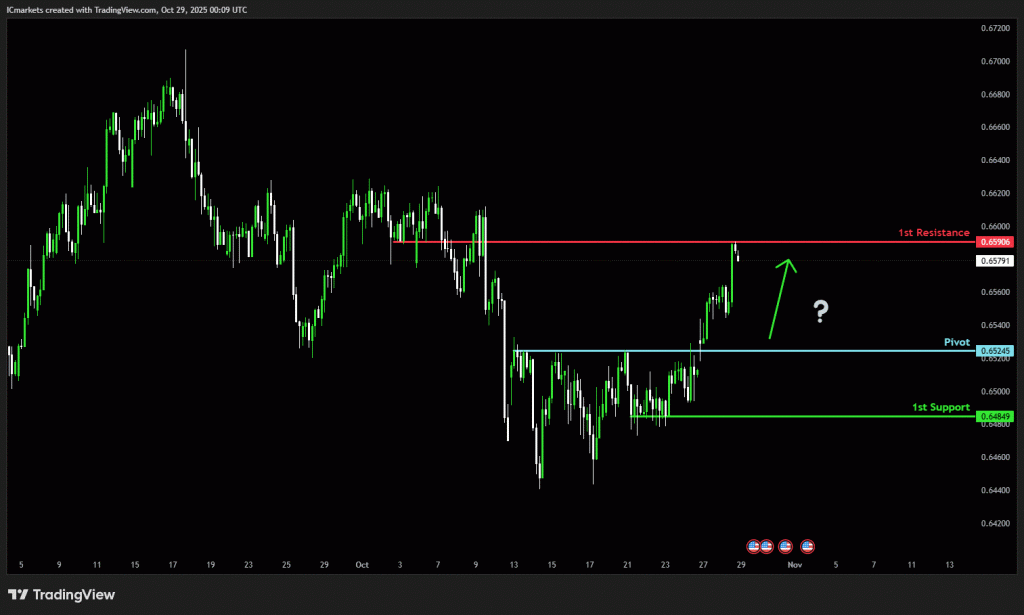
NZD/USD
Potential Direction: Bearish
Overall momentum of the chart: Bullish
The price could see a short-term pullback toward the pivot before continuing its bearish move down toward the 1st support.
Pivot: 0.5803
Supporting reasons: Identified as a pullback resistance that aligns with the 78.6% Fibonacci retracement, where selling pressures could intensify and potentially cap any upward retracement.
1st support: 0.5755
Supporting reasons: Identified as an overlap support., this area has provided strong support historically and may attract buying interest for a potential short-term bounce
1st resistance: 0.5837
Supporting reasons: Identified as an overlap resistance, indicating a potential area that could halt any further upward movement.
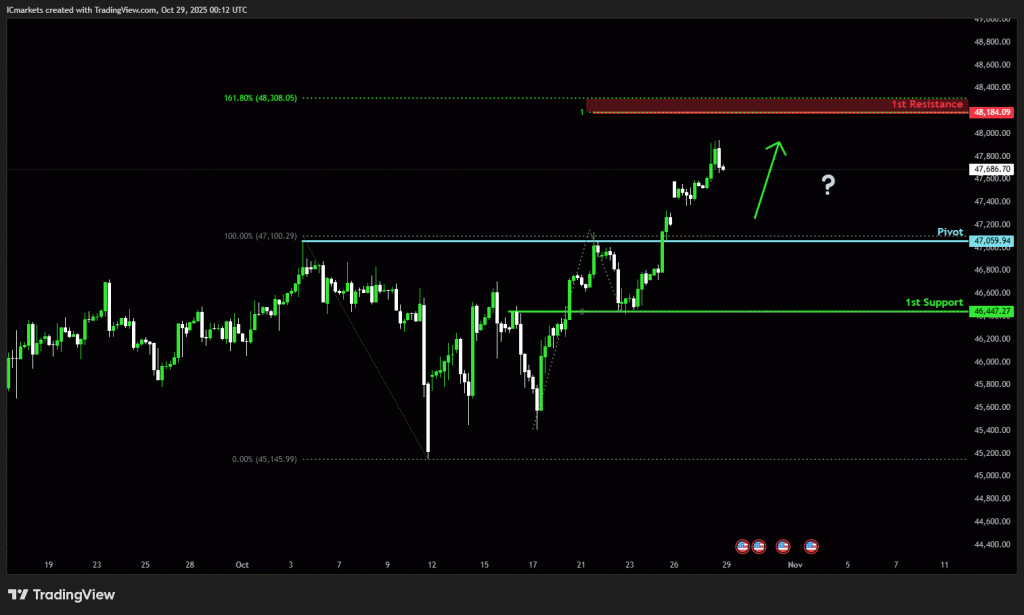
US30 (DJIA):
Potential Direction: Bullish
Overall momentum of the chart: Bullish
The price could see a short-term pullback toward the pivot before rising again toward the 1st resistance.
Pivot: 47,059.94
Supporting reasons: Identified as a pullback support, indicating a potential area where buying interest could pick up
1st support: 46,447.27
Supporting reasons: Identified as a pullback support, suggesting a potential area where the price could stabilize once again.
1st resistance: 48,184.09
Supporting reasons: Identified as a resistance that is supported by the 161.8% Fibonacci extension and the 100% Fibonacci projection, indicating a potential area that could halt any further upward movement.

DE40 (DAX):
Potential Direction: Bullish
Overall momentum of the chart: Bullish
The price has already bounced off the pivot and may continue its bullish move toward the 1st resistance
Pivot: 24,175.32
Supporting reasons: Identified as an overlap support, where renewed buying pressure could emerge to push the price higher.
1st support: 23,935.25
Supporting reasons: Identified as a swing low support, indicating a key level where the price could stabilize once more.
1st resistance: 24,507.17
Supporting reasons: Identified as a pullback resistance, indicating a potential area that could halt any further upward movement.

US500 (S&P 500):
Potential Direction: Bullish
Overall momentum of the chart: Bullish
The price is falling toward the pivot and could make a short-term pullback toward this level before rising again toward the 1st resistance.
Pivot: 6,760.21
Supporting reasons: Identified as a pullback support, indicating a potential area where buying interest could pick up
1st support: 6,696.60
Supporting reasons: Identified as a pullback support, indicating a potential level where the price could stabilize once again.
1st resistance: 6,922.99
Supporting reasons: Identified as a resistance that is supported by the 161.8% Fibonacci extension, indicating a potential area that could halt any further upward movement.
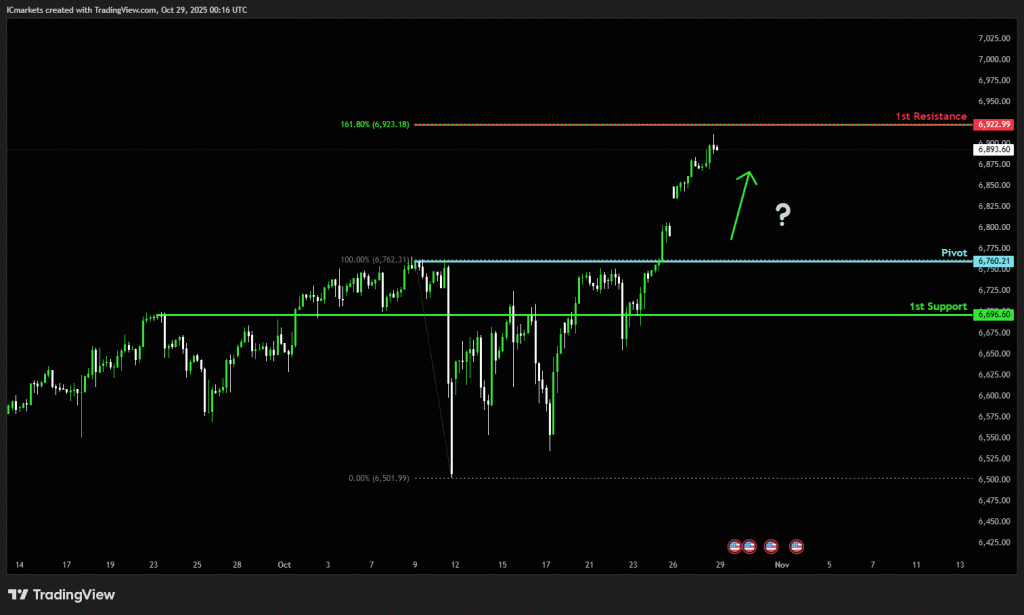
BTC/USD (Bitcoin):
Potential Direction: Bearish
Overall momentum of the chart: Bullish
The price has already reacted off the pivot and may continue its bearish move toward the 1st support
Pivot: 116,139.03
Supporting reasons: Identified as a pullback resistance that aligns with the 100% Fibonacci projection, where selling pressures could intensify and potentially cap any upward retracement
1st support: 109,172.55
Supporting reasons: Identified as a pullback support, indicating a potential level where the price could stabilize once more.
1st resistance: 119,893.62
Supporting reasons: Identified as a pullback resistance, indicating a potential area that could halt any further upward movement.
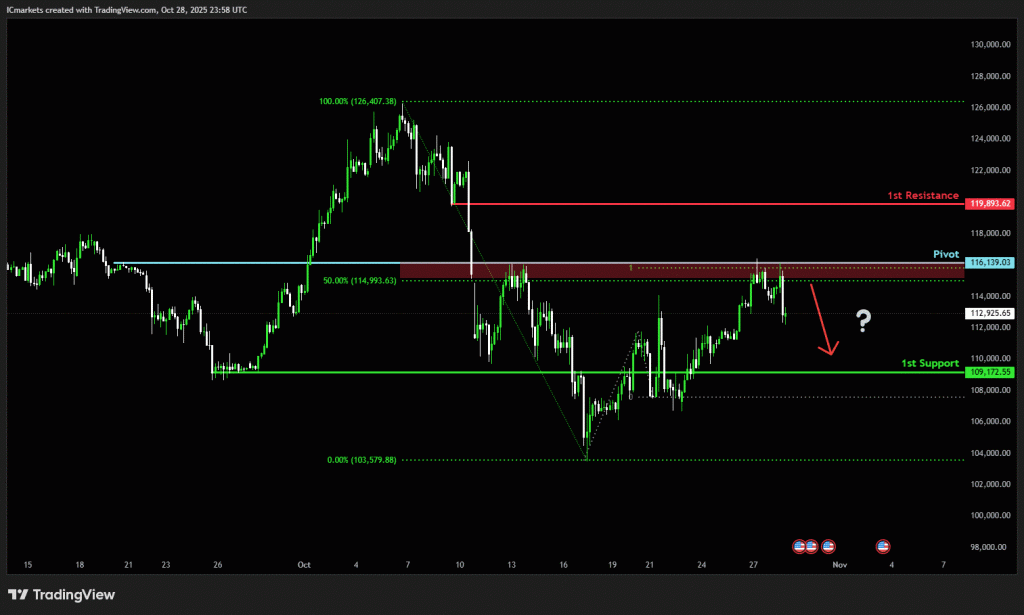
ETH/USD (Ethereum):
Potential Direction: Bullish
Overall momentum of the chart: Bullish
The price has already bounced off the pivot and may continue its bullish move toward the 1st resistance
Pivot: 3,941.17
Supporting reasons: Identified as an overlap support that aligns with the 61.8% Fibonacci retracement, where renewed buying pressure could emerge to push the price higher.
1st support: 3,694.07
Supporting reasons: Identified as a swing low support, indicating a potential level where the price could stabilize once more.
1st resistance: 4,081,99
Supporting reasons: Identified as a pullback resistance, indicating a potential area that could halt any further upward movement.

WTI/USD (Oil):
Potential Direction: Bullish
Overall momentum of the chart: Bullish
The price has already bounced off the pivot and may continue its bullish move toward the 1st resistance
Pivot: 60.18
Supporting reasons: Identified as an overlap support that aligns with the 38.2% Fibonacci retracement, where renewed buying pressure could emerge to push the price higher.
1st support: 57.72
Supporting reasons: Identified as a pullback support that aligns with the 78.6% Fibonacci retracement, indicating a key level where the price could stabilize once more.
1st resistance: 63.15
Supporting reasons: Identified as an overlap resistance that aligns with the 61.8% Fibonacci retracement, indicating a potential area that could halt any further upward movement.
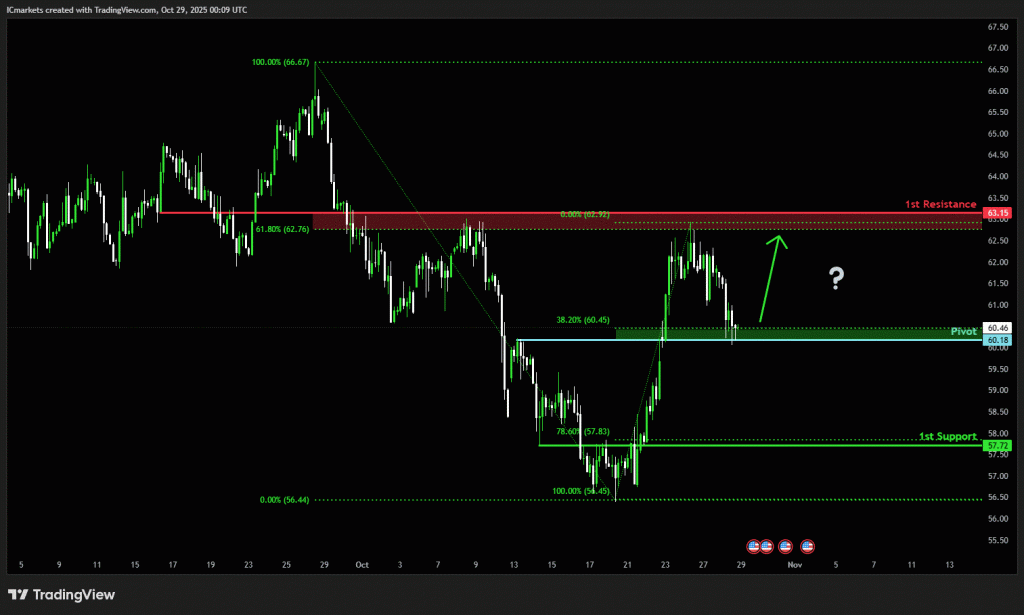
XAU/USD (GOLD):
Potential Direction: Bearish
Overall momentum of the chart: Bullish
The price could see a short-term pullback toward the pivot before continuing its bearish move down toward the 1st support.
Pivot: 4,053.83
Supporting reasons: Identified as a pullback resistance, where selling pressures could intensify and potentially cap any upward retracement.
1st support: 3,891.10
Supporting reasons: Identified as an overlap support that aligns closely with the 78.6% Fibonacci projection, indicating a key level where the price could stabilize once more.
1st resistance: 4,177.54
Supporting reasons: Identified as a pullback resistance, indicating a potential area that could halt any further upward movement.

The accuracy, completeness and timeliness of the information contained on this site cannot be guaranteed. IC Markets does not warranty, guarantee or make any representations, or assume any liability regarding financial results based on the use of the information in the site.
News, views, opinions, recommendations and other information obtained from sources outside of www.icmarkets.com, used in this site are believed to be reliable, but we cannot guarantee their accuracy or completeness. All such information is subject to change at any time without notice. IC Markets assumes no responsibility for the content of any linked site.
The fact that such links may exist does not indicate approval or endorsement of any material contained on any linked site. IC Markets is not liable for any harm caused by the transmission, through accessing the services or information on this site, of a computer virus, or other computer code or programming device that might be used to access, delete, damage, disable, disrupt or otherwise impede in any manner, the operation of the site or of any user’s software, hardware, data or property.
The post Wednesday 29th October 2025: Technical Outlook and Review first appeared on IC Markets | Official Blog.
IC Markets – Asia Fundamental Forecast | 29 October 2025
422833 October 29, 2025 18:00 ICMarkets Market News
IC Markets – Asia Fundamental Forecast | 29 October 2025
What happened in the U.S. session?
Strong corporate earnings and expectations for easier Fed policy propelled U.S. equities and technology stocks to new highs overnight. Fixed income saw yields decline in anticipation of rate cuts, while gold prices fell sharply as risk appetite increased. The macroeconomic backdrop remained clouded by reduced consumer confidence and labor-market caution, but optimism around AI and dovish central bank action dominated market sentiment. Data scarcity because of the government shutdown meant traders relied on private releases and forward guidance more heavily than usual.
What does it mean for the Asia Session?
Wednesday’s Asian session is likely to be dominated by pre-positioning and volatility around high-impact CPI and central bank releases, with particular attention to AUD, CAD, NZD, and USD pairs. Traders are urged to watch for shifts in rate expectations, central bank rhetoric, and themes of risk-on/risk-off sentiment as global markets continue to react to monetary policy divergence and evolving geopolitical headlines.
The Dollar Index (DXY)
Key news events today
Federal funds rate (6:00 pm GMT)
FOMC statement (6:00 pm GMT)
FOMC Press Conference (6:30 pm GMT)
What can we expect from DXY today?
The US Dollar is under pressure today as traders focus on the Fed’s policy direction. The anticipated rate cut reflects concerns over job growth and muted inflation, with economic uncertainty amplified by delays in official US data due to the federal shutdown. Investors are bracing for volatility following the FOMC announcement and the press conference, which will set the tone for the dollar and global markets in the coming weeks.
Central Bank Notes:
- The Federal Open Market Committee (FOMC) voted, by majority, to lower the federal funds rate target range by 25 basis points to 3.75%–4.00% at its October 28–29, 2025, meeting, marking the second consecutive cut following the 25 basis points reduction in September.
- The Committee maintained its long-term objectives of maximum employment and 2% inflation, noting that the labor market continues to soften, with modest job creation and an unemployment rate edging higher. In comparison, inflation remains above target at around 3.0%.
- Policymakers highlighted ongoing downside risks to economic growth, tempered by signs of resilient economic activity. September’s consumer price index (CPI) came in slightly lower than expected at 3.0% year-over-year, easing inflation pressure but still warranting vigilance given tariff-driven price effects.
- Economic activity expanded modestly in the third quarter, with GDP growth estimates around 1.0% annualized; however, uncertainty remains elevated amid persistent global trade tensions and the U.S. government shutdown, which is impacting data availability.
- The updated Summary of Economic Projections reflects an anticipated unemployment rate averaging approximately 4.5% for 2025, with headline and core personal consumption expenditures (PCE) inflation projections holding near 3.0%, indicating a slow easing path ahead.
- The Committee emphasized its flexible, data-dependent approach and underscored that future policy adjustments will be guided by incoming labor market and inflation data. As in prior meetings, there was dissent, including one member advocating a more aggressive 50-basis-point cut.
- The FOMC announced the planned conclusion of its balance sheet reduction (quantitative tightening) program, intending to cease runoff in the near term to maintain market stability, with Treasury redemption caps held steady at $5 billion per month and agency mortgage-backed securities caps at $35 billion.
- The next meeting is scheduled for 9 to 10 December 2025.
Next 24 Hours Bias
Weak Bearish
Gold (XAU)
Key news events today
Federal funds rate (6:00 pm GMT)
FOMC statement (6:00 pm GMT)
FOMC Press Conference (6:30 pm GMT)
What can we expect from Gold today?
Gold prices declined sharply at the start of this week and have faced heightened volatility, with spot prices testing the $3,945–$3,965 support zone after plunging below $4,000 due to improved risk sentiment, profit-taking, and optimism over a potential US–China trade deal. A recent rally saw gold reach an all-time high of $4,381.58, but prices have since corrected more than 7% within a week, currently hovering around $3,950–$4,010 as the market awaits the US Fed’s policy decision on October 29, which could trigger further moves depending on interest rate guidance.
Next 24 Hours Bias
Medium Bearish
The Australian Dollar (AUD)
Key news events today
CPI q/q (12:30 am GMT)
CPI y/y (12:30 am GMT)
Trimmed mean CPI q/q (12:30 am GMT)
What can we expect from AUD today?
The Australian Dollar staged a modest rally following stronger-than-expected inflation data, buoyed by external optimism and technical resilience, but remains in a watchful holding pattern ahead of further policy signals. The market sees the recent upside CPI surprise as supportive for the AUD in the near term, easing fears of further rate cuts by the RBA.The AUD remains sensitive to global risk appetite, especially developments in US-China trade relations and upcoming central bank meetings in the US and Australia.
Central Bank Notes:
- The RBA held its cash rate steady at 3.60% at its October meeting on 29–30 September 2025, marking a second consecutive pause after August’s 25 basis point cut. The move affirms the Bank’s data-dependent approach as inflation trends within the target range.
- Inflation indicators remained stable through September, with headline CPI likely anchoring near 2.2%—comfortably within the 2–3% band. Insurance and housing costs remain sticky but are increasingly offset by moderation in discretionary goods.
- Trimmed mean inflation is estimated at around 2.8%, signaling underlying pressures remain contained. The Board continues to flag food and energy price volatility as short-term risks, though the broader disinflation narrative holds.
- Global conditions remain a source of uncertainty. U.S. policy expectations and uneven growth in China continue to weigh on commodities, even as trade disruptions have eased marginally since mid-year.
- Domestic growth shows resilience in the housing and services sectors, though manufacturing remains subdued. Household incomes have stabilized, but consumption remains only modest, capped by high borrowing costs.
- The labor market maintains relative tightness, though job growth has slowed notably since the first half of the year. Underutilization has ticked higher, but overall employment conditions remain supportive.
- Wage growth is plateauing, reflecting softer labor demand. Weak productivity continues to keep unit labor costs elevated, underscoring a medium-term concern highlighted repeatedly by the RBA.
- Household consumption prospects remain fragile. The combination of high rents and weak discretionary appetite suggests risks of a consumer-led slowdown in Q4 if confidence fails to rebound.
- The Board reiterated that subdued household spending poses risks to business sentiment and may dampen investment and job creation in the coming quarters.
- Monetary policy remains mildly restrictive. The RBA balanced confidence in inflation progress with caution around global and domestic demand risks, keeping further adjustments conditional on incoming data.
- The Bank reaffirmed its dual commitment to price stability and full employment, noting its readiness to act should conditions shift markedly.
- The next meeting is on 5 to 6 November 2025.
Next 24 Hours Bias
Medium Bullish
The Kiwi Dollar (NZD)
Key news events today
RBNZ Gov Hawkesby Speaks (3:30 am GMT)
What can we expect from NZD today?
The New Zealand Dollar (NZD) showed moderate gains against the US Dollar on October 29, 2025, supported by easing US-China trade tensions and a modest uptick in market sentiment, tempered by recent dovish monetary signals from the Reserve Bank of New Zealand (RBNZ). The NZD/USD pair exhibited a slight upward momentum, trading around 0.5760–0.5780, but major resistance at 0.5800 remained intact.
Central Bank Notes:
- The Monetary Policy Committee (MPC) agreed to cut the Official Cash Rate (OCR) by 50 basis points to 2.50% on 8 October 2025, exceeding market expectations for a smaller 25-basis-point reduction and signaling a stronger commitment to reviving growth.
- The decision was reached by consensus, marking a shift from previous split votes, and reflected policymakers’ shared view that sustained economic weakness and persistent disinflationary pressures required a more front-loaded policy response.
- Annual consumer price inflation stood at 2.7% in the June quarter and is seen nearing 3% for the September quarter—above the 2% midpoint but within the 1–3% target range. Despite high near-term readings, the MPC projects inflation will return toward 2% by the first half of 2026 as spare capacity and moderating tradables curb price momentum.
- Policymakers acknowledged that domestic demand remains weak, with household spending, business investment, and construction activity under pressure. While still elevated, services inflation is expected to ease gradually as wage growth slows and unemployment edges higher.
- Financial conditions have eased with expectations as wholesale and retail borrowing rates adjust to lower policy settings. Bank lending data indicate a modest uptick in mortgage approvals, though broader credit demand remains subdued.
- GDP growth stalled in the middle of 2025, with high-frequency indicators showing continued weakness into the third quarter. A combination of elevated costs for essentials and falling savings continues to restrain household consumption, while global trade frictions weigh on business sentiment.
- The MPC noted that global uncertainty—particularly from US trade regulation changes and soft Chinese demand—continues to pose downside risks to export sectors, though these are partly offset by a weaker New Zealand dollar improving competitiveness.
- Subject to data confirming a sustained soft patch in activity and moderating inflation pressures, the MPC signaled further scope to reduce the OCR toward 2.25% at its next meeting on 26 November 2025, consistent with current market and Westpac forecasts.
- The next meeting is on 26 November 2025.
Next 24 Hours Bias
Weak Bullish
The Japanese Yen (JPY)
Key news events today
No major news event
What can we expect from JPY today?
On October 29, 2025, the Japanese Yen is rebounding on intervention fears and speculation about Bank of Japan policy. Markets expect rates to remain steady, but forward guidance and economic projections could set the tone for Yen moves into the year-end. Fiscal stimulus under PM Takaichi and persistent inflation are key drivers, with traders closely watching upcoming BOJ decisions and statements for clues about future tightening.
Central Bank Notes:
- The Policy Board of the Bank of Japan decided on 17 September, by a unanimous vote, to set the following guidelines for money market operations for the inter-meeting period:
- The Bank will encourage the uncollateralized overnight call rate to remain at around 0.5%.
- The BOJ will continue its gradual reduction of monthly outright purchases of Japanese Government Bonds (JGBs). The scheduled amount of long-term government bond purchases remains unchanged from the prior decision, with a quarterly reduction pace of about ¥400 billion through March 2026 and about ¥200 billion per quarter from April to June 2026 onward, aiming for a purchase level near ¥2 trillion in January to March 2027.
- Japan’s economy continues to show a moderate recovery, with household consumption supported by rising incomes, although corporate activity has softened somewhat. Overseas economies remain on a moderate growth path, with the impact of global trade policies still weighing on Japan’s export and industrial production outlook.
- On the price front, the year-on-year rate of change in consumer prices (excluding fresh food) remains in the mid-3% range. Inflationary pressures remain broad-based, with persistent cost-push factors in food and energy, alongside solid wage pass-through. However, input cost pressures from past import surges are showing early signs of easing.
- Short-term inflation momentum may moderate as cost-push effects diminish, though rent increases and service-related price gains tied to labor shortages are likely to provide support. Inflation expectations among firms and households continue a gradual upward drift.
- Looking ahead, the economy is projected to grow at a slower-than-trend pace in the near term due to external demand softness and cautious corporate investment plans. However, accommodative financial conditions and steady increases in real labor income are expected to underpin domestic demand.
- In the medium term, as overseas economies recover and global trade stabilizes, Japan’s growth potential is likely to improve. With persistent labor market tightness and rising medium- to long-term inflation expectations, core inflation is projected to remain on a gradual upward trend, converging toward the 2% price stability target in the latter half of the projection horizon.
- The next meeting is scheduled for 30 to 31 October 2025.
Next 24 Hours Bias
weak Bearish
Oil
Key news events today
EIA crude oil inventories (2:30 pm GMT)
What can we expect from Oil today?
Oil markets on Wednesday face a complex interplay of bearish and bullish forces. While sanctions on Russian oil producers and improving US-China trade relations provide some price support, the dominant narrative remains one of oversupply concerns driven by OPEC+ production increases and weak demand growth projections. The upcoming OPEC+ meeting on November 2 and official US inventory data release on October 29 will provide critical direction for near-term price movements.
Next 24 Hours Bias
Medium Bearish
The post IC Markets – Asia Fundamental Forecast | 29 October 2025 first appeared on IC Markets | Official Blog.
Wednesday 29th October 2025: Asian Markets Mixed Ahead of Fed Rate Decision
422832 October 29, 2025 17:39 ICMarkets Market News
Global Markets:
- Asian Stock Markets : Nikkei up 2.00%, Shanghai Composite up 0.37%, Hang Seng down -0.33% ASX down -0.99%
- Commodities : Gold at $3,981.19 (-0.05%), Silver at $47.480 (0.33%), Brent Oil at $63.73 (-0.16%), WTI Oil at $60.05 (-0.17%)
- Rates : US 10-year yield at 3.982, UK 10-year yield at 4.4030, Germany 10-year yield at 2.6212
News & Data:
- (USD) Richmond Manufacturing Index -4 to -11 expected
Markets Update:
Asian stock markets traded mixed on Wednesday, following positive overnight cues from Wall Street, as investors remained cautious ahead of the U.S. Federal Reserve’s interest rate decision later in the day. Optimism about a potential U.S.-China trade deal also supported sentiment. The Fed is widely expected to cut rates by another quarter point, with attention focused on Chair Jerome Powell’s comments for hints of future policy moves. According to CME Group’s FedWatch Tool, there is a 90.8% chance of another rate cut in December, though expectations for early 2026 remain divided.
In Australia, the S&P/ASX 200 Index slipped 0.73% to 8,946.50, weighed down by losses in banking and technology stocks, despite gains in gold miners. The CPI rose 3.5% year-on-year in September, exceeding expectations and marking the highest reading since July 2024. The Australian dollar traded at $0.659.
Japan’s Nikkei 225 surged 2.05% to 51,249.82, led by strong gains in technology and exporter stocks. Advantest jumped over 20%, while Tokyo Electron and Screen Holdings gained around 3%.
Elsewhere in Asia, South Korea gained 1.4%, while Singapore, Malaysia, and Indonesia slipped marginally. On Wall Street, major U.S. indices closed higher, extending Monday’s rally, with the Nasdaq up 0.8% and the Dow up 0.3%. Crude oil prices fell 2.2% to $59.99 per barrel on reports of potential OPEC production hikes.
Upcoming Events:
- 01:45 PM GMT – CAD Overnight Rate
- 06:00 PM GMT – USD Federal Funds Rate
- 06:00 PM GMT – USD FOMC Statement
The post Wednesday 29th October 2025: Asian Markets Mixed Ahead of Fed Rate Decision first appeared on IC Markets | Official Blog.
IC Markets – Europe Fundamental Forecast | 29 October 2025
422831 October 29, 2025 17:39 ICMarkets Market News
IC Markets – Europe Fundamental Forecast | 29 October 2025
What happened in the Asia session?
Today’s Asia session was driven by upbeat market sentiment on progress in US–China trade negotiations, hotter-than-expected Australian inflation data, and anticipation of major central bank rate decisions. Risk assets outperformed, Asian currencies firmed, and technology stocks led rallies across the region, while the US dollar softened ahead of the Federal Reserve meeting.
What does it mean for the Europe & US sessions?
October 29, 2025, brings critical central bank decisions from the Federal Reserve (2:00 PM ET) and Bank of Canada (1:45 PM UTC), with both expected to deliver 25 basis point rate cuts. Australia’s inflation surged to 3.2% annually, the highest since June 2024, driven by a 9% jump in electricity costs, effectively ruling out near-term RBA rate cuts. U.S. stock indices hit fresh records on Tuesday, led by Nvidia, while Asian markets rallied ahead of the Fed decision.
The Dollar Index (DXY)
Key news events today
Federal funds rate (6:00 pm GMT)
FOMC statement (6:00 pm GMT)
FOMC Press Conference (6:30 pm GMT)
What can we expect from DXY today?
The US Dollar faces pressure from the anticipated Federal Reserve rate cut, government-induced data blackout, and global policy divergence. Today’s FOMC decision is critical—while markets expect a 0.25% rate cut, any unexpected forward guidance from Chair Powell could trigger volatility. The dollar remains soft against major peers, with eyes on how policy changes and risk sentiment interplay in the coming days.
Central Bank Notes:
- The Federal Open Market Committee (FOMC) voted, by majority, to lower the federal funds rate target range by 25 basis points to 3.75%–4.00% at its October 28–29, 2025, meeting, marking the second consecutive cut following the 25 basis points reduction in September.
- The Committee maintained its long-term objectives of maximum employment and 2% inflation, noting that the labor market continues to soften, with modest job creation and an unemployment rate edging higher. In comparison, inflation remains above target at around 3.0%.
- Policymakers highlighted ongoing downside risks to economic growth, tempered by signs of resilient economic activity. September’s consumer price index (CPI) came in slightly lower than expected at 3.0% year-over-year, easing inflation pressure but still warranting vigilance given tariff-driven price effects.
- Economic activity expanded modestly in the third quarter, with GDP growth estimates around 1.0% annualized; however, uncertainty remains elevated amid persistent global trade tensions and the U.S. government shutdown, which is impacting data availability.
- The updated Summary of Economic Projections reflects an anticipated unemployment rate averaging approximately 4.5% for 2025, with headline and core personal consumption expenditures (PCE) inflation projections holding near 3.0%, indicating a slow easing path ahead.
- The Committee emphasized its flexible, data-dependent approach and underscored that future policy adjustments will be guided by incoming labor market and inflation data. As in prior meetings, there was dissent, including one member advocating a more aggressive 50-basis-point cut.
- The FOMC announced the planned conclusion of its balance sheet reduction (quantitative tightening) program, intending to cease runoff in the near term to maintain market stability, with Treasury redemption caps held steady at $5 billion per month and agency mortgage-backed securities caps at $35 billion.
- The next meeting is scheduled for 9 to 10 December 2025.
Next 24 Hours Bias
Medium Bearish
Gold (XAU)
Key news events today
Federal funds rate (6:00 pm GMT)
FOMC statement (6:00 pm GMT)
FOMC Press Conference (6:30 pm GMT)
What can we expect from Gold today?
Gold prices rebounded on Wednesday, as traders returned for bargain hunting after the precious metal dropped to a three-week low earlier in the week. Spot gold traded around $3,975-$3,978 per ounce, up approximately 0.60-0.66% from the previous day. After surging more than 60% year-to-date and reaching an all-time high of $4,382 per ounce on October 20, gold has experienced significant volatility, pulling back over 7% in just five trading sessions.
Next 24 Hours Bias
Weak Bearish
The Euro (EUR)
Key news events today
No major news event
What can we expect from EUR today?
The Euro enters the final days of October on a relatively firm footing, supported by stronger-than-expected economic growth data, stabilizing inflation near target, and an ECB that has successfully concluded its easing cycle. Germany’s surprisingly robust PMI performance has boosted confidence in the eurozone’s growth trajectory for Q4 2025, while the resolution of some US tariff uncertainties has reduced external headwinds.
Central Bank Notes:
- The Governing Council kept the three key ECB interest rates unchanged at its meeting on October 30, 2025. The main refinancing rate remains at 2.15%, the marginal lending facility at 2.40%, and the deposit facility at 2.00%. This decision reflects policymakers’ assessment that the current monetary stance remains consistent with medium-term price stability, while incoming data confirm a gradual return of inflation towards the target.
- Recent indicators point to stable price dynamics. Headline inflation remains near the 2% mark, with energy prices contained and food inflation easing slightly after earlier supply bottlenecks. Wage growth continues to moderate, contributing to the slowdown in domestic cost pressures. The ECB reiterated its commitment to a data-driven, meeting-by-meeting approach and emphasized flexibility amid uncertain global financial conditions.
- Eurosystem staff projections have not been materially altered since September. Headline inflation averages remain at 2.0% for 2025, 1.8% for 2026, and 2.0% for 2027. Recent softening in producer prices and subdued pipeline pressures suggest limited upside risks to inflation, though geopolitical tensions and potential commodity shocks continue to pose uncertainties to the outlook.
- Euro area GDP growth remains on track with earlier forecasts, projected at 1.1% for 2025, 1.1% for 2026, and 1.4% for 2027. Forward-looking indicators, including PMIs and industrial sentiment surveys, signal some stabilization in activity following weakness in the third quarter. Public investment and recovering export activity are expected to offset softer private sector demand in the near term.
- The labor market remains resilient, with unemployment rates at multi-decade lows and participation rates strong. Real income growth continues to support household spending, even as consumption growth normalizes from earlier highs. Financing conditions remain favorable, aided by stable banking sector liquidity and improved credit demand among small and medium-sized firms.
- Business sentiment remains mixed, reflecting lingering uncertainty over global trade policy and the path of US tariffs. However, easing supply chain costs and improved export competitiveness due to softer exchange rates are providing some relief to manufacturing and external-oriented sectors.
- The Governing Council reaffirmed that future decisions will depend on an integrated assessment of incoming data—covering inflation trends, financial conditions, and the state of policy transmission. The Council emphasized that no pre-set path for rates exists; keeping all options open should the economic outlook shift markedly.
- Balance sheet reduction continues smoothly, with holdings under the APP and PEPP declining as reinvestments have ceased. The ECB confirmed that the pace of portfolio runoff remains in line with its previously communicated normalization plan, supporting a gradual withdrawal of monetary accommodation in a predictable manner.
- The next meeting is on 17 to 18 December 2025
Next 24 Hours Bias
Weak Bullish
The Swiss Franc (CHF)
Key news events today
No major news event
What can we expect from CHF today?
The Swiss Franc’s strength stems from a confluence of factors: elevated global uncertainty driving safe-haven demand, the SNB’s decision to hold rates steady while dismissing further easing, and the Federal Reserve’s continued dovish stance. While punitive US tariffs weighing on the Swiss economy have prompted growth downgrades, strong pharmaceutical exports and the franc’s safe-haven status continue supporting the currency.
Central Bank Notes:
- The SNB maintained its key policy rate at 0% during its meeting on 25 September 2025, pausing a sequence of six consecutive rate cuts as inflation stabilized and the Swiss franc remained firm.
- Recent data showed a modest rebound in inflation, with Swiss consumer prices rising 0.2% year-on-year in August after staying above zero for three consecutive months; this helped alleviate fears of deflation that were mounting earlier in the year.
- The conditional inflation forecast remains broadly unchanged from June: headline inflation is expected to average 0.2% in 2025, 0.5% in 2026, and 0.7% in 2027. The risk of a negative rate move has diminished for now, but the SNB retains flexibility should inflationary pressures weaken again.
- The global economic outlook has deteriorated further, weighed down by heightened trade tensions—especially with the U.S.—and ongoing uncertainty in key Swiss export markets.
- Swiss GDP growth moderated in Q2 after a strong Q1 boosted by front-loaded U.S. exports. The SNB expects growth to slow and remain subdued, with forecasted GDP expansion between 1% and 1.5% in both 2025 and 2026.
- Labor market sentiment in the Swiss industrial sector has softened on concerns over export competitiveness and potential adjustments to production, but the overall growth outlook stays broadly unchanged
- The SNB reiterated its readiness to respond as needed if deflation risks re-emerge, emphasizing its commitment to medium-term price stability and a robust, transparent communication policy, with the introduction of more detailed monetary policy minutes beginning in October.
- The next meeting is on 11 December 2025.
Next 24 Hours Bias
Medium Bullish
The Pound (GBP)
Key news events today
No major event
What can we expect from GBP today?
Sterling is under pressure from mounting fiscal challenges and budget uncertainty as the UK faces a potential £20-30 billion fiscal shortfall ahead of the November 26 Autumn Budget. While retail price deflation offers some relief, inflation remains well above the Bank of England’s 2% target at 3.8%, limiting the central bank’s ability to cut rates in the near term. The pound has weakened to two-month lows against the euro and faces technical pressure, with Brexit’s ongoing economic impact continuing to constrain productivity and growth prospects.
Central Bank Notes:
- The Bank of England’s Monetary Policy Committee (MPC) voted on 18 September 2025 by a majority (expected split likely 7–2 or 6–3) to hold the Bank Rate steady at 4.00%, following the rate cut in August. Most members cited persistent inflation and mixed indicators on growth and employment, while a minority favored further easing due to the cooling labor market and subdued GDP growth.
- The Committee decided to decrease the pace of quantitative tightening, planning to reduce the stock of UK government bond purchases by £67.5 billion over the next 12 months, instead of the prior £100 billion pace, with the gilt balance now standing at nearly £558 billion. This reflects increased volatility in bond markets and a shift to a more gradual approach.
- Headline inflation rose unexpectedly to 3.8% in July and is projected at 4% for September, above the Bank’s 2% target. Price pressures are driven by regulated energy costs and ongoing food price increases. While previous disinflation has been substantial, core inflation remains elevated and sticky.
- The MPC expects headline inflation to remain above target through Q4, with a resumption of the downward trend projected for early 2026 as energy and regulated price pressures abate. The Committee remains watchful for signs of persistent inflation despite previous policy tightening.
- UK GDP growth is stagnant, with business and consumer activity subdued. Recent labor market data show rising unemployment rates (now at 4.7%) and stabilizing wage growth (holding near 5%), indicating slack but continued wage price pressure. The Committee remains cautious amid lackluster demand and soft survey sentiment.
- Pay growth and employment indicators have moderated further, alongside confirmation from business surveys that pay settlements are slowing. The Committee expects wage growth to decelerate significantly through Q4 and the rest of 2025.
- Global uncertainty persists due to volatile energy prices, supply chain disruptions linked to Middle East conflicts, and renewed trade tensions. The MPC remains vigilant in tracking transmission of external cost/wage shocks to UK inflation.
- Risks to inflation are considered two-sided. While subdued domestic growth and softening labor activity suggest scope for easing, persistent inflation requires caution. The MPC anticipates a slow, gradual reduction path in rates, continuing its data-dependent approach with careful adjustment as warranted by economic developments.
- The Committee’s bias remains toward maintaining a restrictive monetary policy stance until firmer evidence emerges that inflation will return sustainably to the 2% target. All future decisions will remain highly data dependent, with a strong emphasis on evolving demand, inflation expectations, costs, and labor market conditions.
- The next meeting is on 6 November 2025.
Next 24 Hours Bias
Medium Bearish
The Canadian Dollar (CAD)
Key news events today
BOC monetary policy report (1:45 pm GMT)
BOC rate statement (1:45 pm GMT)
Overnight rate (1:45 pm GMT)
Pending Home Sales m/m (2:00 pm GMT)
What can we expect from CAD today?
The BoC is widely expected to cut rates by 25 basis points to 2.25%, marking the ninth cut since last summer and bringing the overnight rate to the lower bound of its neutral range. Despite September inflation accelerating to 2.4%, economic weakness—including a 1.6% Q2 GDP contraction, elevated 7.1% unemployment, and deteriorating business confidence—justifies continued easing.
Central Bank Notes:
- The Council noted that U.S. tariff tensions have eased slightly following early progress in bilateral discussions, though the external trade environment remains fragile. Businesses continue to hold back on long-term investment, with the Bank highlighting that sustained clarity on U.S. trade policy is needed to restore confidence.
- The Bank acknowledged that uncertainty persists despite the softer U.S. tone, as incoming data show limited improvement in export orders. The manufacturing sector has stabilized but remains below pre-2024 output levels, reflecting weak global demand and cautious corporate spending.
- Canada’s economy showed tentative signs of recovery in early Q4, with GDP estimated to expand by 0.3% in October after two quarters of contraction. Mining and energy activity strengthened modestly, aided by steady crude demand, while goods exports posted a fractional gain.
- Service sector growth remained uneven, supported mainly by tourism-related and technology services. However, retail spending and household consumption were subdued, constrained by slower job creation and lingering consumer caution. The Bank judged overall momentum as fragile but improving marginally.
- Housing activity showed modest reacceleration in major urban markets as mortgage rates stabilized near record lows. Nonetheless, affordability pressures and stricter lending standards continue to cap overall resale volumes, leading to only a gradual recovery in the housing sector.
- Headline CPI inflation rose to 2.1% in October, reaching the Bank’s target for the first time in six months. The increase was driven by higher energy prices and a modest uptick in food and shelter costs. Core inflation measures remained stable, suggesting underlying price pressures are contained.
- The Governing Council reiterated its data-dependent stance, indicating that the current policy rate remains appropriate amid tentative growth and balanced inflation risks. Officials noted that while additional stimulus is not ruled out, the emphasis has shifted toward monitoring the sustainability of the recovery rather than immediate rate adjustments.
- The next meeting is on 17 to 18 December 2025.
Next 24 Hours Bias
Weak Bearish
Oil
Key news events today
EIA crude oil inventories (2:30 pm GMT)
What can we expect from Oil today?
Oil markets are navigating a complex landscape of competing pressures. Prices have stabilized around $60/barrel for WTI and $65/barrel for Brent after a three-day decline, as bearish fundamentals from OPEC+ production increases clash with supportive factors, including US-China trade progress and Russian sanctions.The dominant concern remains oversupply, with OPEC+ poised to approve another 137,000 bpd production increase for December at its November 2 meeting.
Next 24 Hours Bias
Weak Bearish
The post IC Markets – Europe Fundamental Forecast | 29 October 2025 first appeared on IC Markets | Official Blog.
Ex-Dividend 28/10/2025
422750 October 27, 2025 17:00 ICMarkets Market News
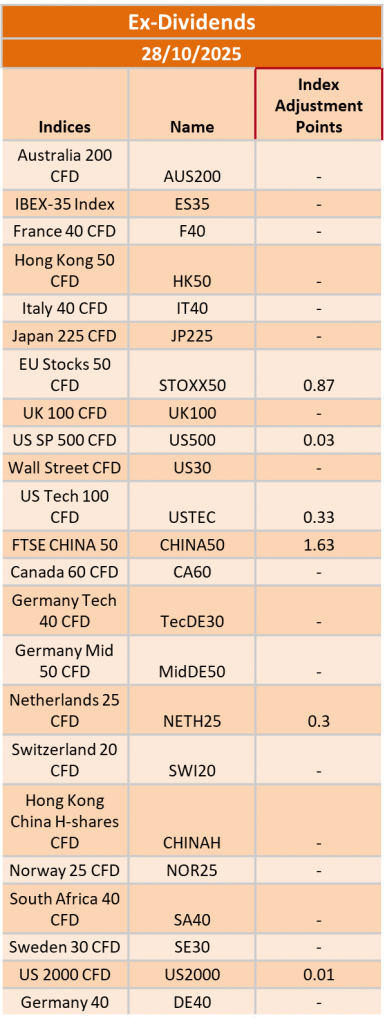
The post Ex-Dividend 28/10/2025 first appeared on IC Markets | Official Blog.
General Market Analysis – 27/10/25
422747 October 27, 2025 16:00 ICMarkets Market News
US Stocks Rally after Weaker CPI – Nasdaq up 1.15%
US stock markets rallied strongly into the weekend on Friday to hit fresh record levels after a weaker-than-expected CPI number and strong earnings reports helped drive investor sentiment higher. The Dow added 1.01% to move up to 47,207, the S&P gained 0.79% to 6,791, and the Nasdaq finished up 1.15% at 23,204. The dollar had a mixed day against the majors despite the weaker number, the DXY closing the day flat at 98.94, while Treasury yields were also unimpressed with the data, the 2-year closing down just 0.9 of a basis point at 3.480%, and the benchmark 10-year closing flat at 4.001%. Oil prices drifted lower off recent highs, Brent down 0.35% at $65.76 and WTI down 0.47% at $61.50 a barrel. Gold also fell to lock in its first down week in 10, closing the day down 0.32% at $4,113.05 an ounce.
Central Banks in Focus this Week
It is a huge week ahead for major central banks, with four big players set to announce interest rate decisions. FX traders will be paying particular attention, as any surprises or major changes in forward guidance could see long-term interest rate differential trades take a change of direction. We are expecting 25 basis point cuts from both the Bank of Canada and the Federal Reserve on Wednesday, with the Bank of Japan and the European Central Bank expected to keep rates steady on Thursday. As always, and barring any surprise moves, the devil will be in the detail, and FX players are expected to see some big moves in currencies around all events. Geopolitical updates will play a major role in all announcements from the major banks, with tariffs and trade issues front and centre for both the Fed and the Bank of Canada, while recent changes in government and the Bank of Japan’s reaction will be a huge focus for yen traders.
Quiet Trading Day to Start a Big Week
It is a quiet start to a busy calendar week today, with little scheduled to move the market. However, news out of Malaysia from both the US and China camps on trade talk progress is positive and should combine with Friday’s strong day on Wall Street to see a good start on the Asian open. New Zealand markets are closed for a bank holiday, but this is not expected to have a significant impact on liquidity. There will be a strong focus on Australian markets towards the end of the session, with Reserve Bank of Australia Governor Michele Bullock due to speak in Sydney. The London session will see German IFO Business Climate data released, with the market expecting an 88.1 print, and we should see moves in the euro around the release. There is little scheduled on the calendar in the New York session, although Canadian markets are expected to kick off on the back foot after President Trump confirmed a 10% increase in tariffs over the weekend. Traders are expecting geopolitical updates to dominate flow today, and at present, they do seem to be largely positive; however, many are aware of how swiftly that can change in current market conditions.
The post General Market Analysis – 27/10/25 first appeared on IC Markets | Official Blog.
The Week Ahead – Week Commencing 27 October 2025
422741 October 27, 2025 16:00 ICMarkets Market News
It was another busy week in financial markets last week that ended on a high for stock investors, as earnings reports and a weaker CPI print pushed US indices back to record levels on Friday. Gold was volatile again but notably recorded its first weekly loss in ten, and oil surged as fresh sanctions were placed on Russia by the US.
It is likely to be another busy week for investors ahead, with a plethora of major central bank rate calls likely to battle with more new geopolitical updates for market sentiment. The US government shutdown, and the consequent lack of data, looks set to continue into another week, which will detract from fundamental updates and may start to weigh on local sentiment.
There are major earnings reports due again out of the US, and investors will be hoping for more good news to maintain the current sentiment.
Here is our usual day-by-day breakdown of the major risk events this week:

It’s a quiet start to the week on Monday on the event calendar, although traders will be looking for US–China trade updates from Kuala Lumpur for initial direction. We do hear from RBA Governor Michele Bullock later in the day, and the German IFO Business Climate numbers are due out; however, most investors are expecting geopolitics to dominate sentiment.

Another quiet day on Tuesday before things start to pick up, with little again on the calendar. The first two sessions of the day are lacking any significant events scheduled, and in the US, we have the Richmond Manufacturing Index data due out, but once again traders will focus on newswires for any fresh direction.

The initial focus in Asian markets will be on Australia, with key CPI numbers due out. Focus will jump across the Tasman later in the day with RBNZ Governor Christian Hawkesby due to speak later in the day. There is little of note on the calendar in the London session; however, things will pick up once New York comes in. Again, we have both North American central banks set to deliver rate updates on the same day, with first the Bank of Canada making its announcement from Ottawa before, a few hours later, we get the key update from the Fed in Washington DC.

The focus will be squarely on Japanese markets in the Asian session on Thursday, with the Bank of Japan set to update the market on its rate decision. Extra emphasis is being placed on this meeting given recent government changes, with any forward guidance likely to lead to big swings in the yen. We have CPI data out of Germany and Spain early in the London session; however, the big focus will be on the ECB when they make their rate announcement midway through the day. There is GDP data scheduled in the US later in the day, although at the moment the chances of a release are low given the government shutdown.

The initial focus in Asia will again be on Japanese markets, with the Tokyo Core CPI numbers due out; however, it will then jump to China for the release of the PMI data. The London session will see the release of the EU Flash CPI data, and Canadian GDP numbers are due out shortly after the New York open. US Core PCE Price Index data and Employment Cost numbers are again pencilled in; however, once again, this is largely dependent on whether the government shutdown continues.
The post The Week Ahead – Week Commencing 27 October 2025 first appeared on IC Markets | Official Blog.
IC Markets – Europe Fundamental Forecast | 27 October 2025
422740 October 27, 2025 15:39 ICMarkets Market News
IC Markets – Europe Fundamental Forecast | 27 October 2025
What happened in the Asia session?
The session was defined by strong risk-on momentum driven by positive US–China trade headlines and anticipation of further central bank updates.Equities, copper, and oil led the rally. AUD and NZD also performed well, while gold declined on lower risk aversion. Market participants remain focused on upcoming central bank meetings and confirmation that any trade truce will be sustained.
What does it mean for the Europe & US sessions?
Markets begin the week with risk-positive sentiment on trade optimism, but remain sensitive to policy signals from central banks and global political risks.Expect potential volatility around macroeconomic data releases and speeches, and monitor headlines for any abrupt shifts in sentiment as the U.S. and European trading day unfolds.
The Dollar Index (DXY)
Key news events today
No major news event
What can we expect from DXY today?
The US dollar remains resilient but is little changed as markets brace for key central bank decisions and global trade negotiations. The expectation of a Fed rate cut is keeping the dollar in a relatively tight range, while ongoing trade optimism is encouraging risk-taking, with stocks rising and cross-currency movements remaining mild. The dollar hit a two-week high against the yen at the start of Monday trading amid heightened anticipation around global trade talks and central bank meetings during the week.
Central Bank Notes:
- The Federal Open Market Committee (FOMC) voted, by majority, to lower the federal funds rate target range by 25 basis points to 4.00%–4.25% at its September 16–17, 2025, meeting, marking the first policy rate adjustment since December 2024 after five consecutive holds.
- The Committee maintained its long-term objective of achieving maximum employment and 2% inflation, acknowledging recent labor market softening and continued tariff-driven price pressures.
- Policymakers expressed elevated concern about downside risks to growth, citing a stalling labor market, modest job creation, and an unemployment rate drifting up toward 4.4%. At the same time, inflation remains above target, with CPI at 3.2% and core inflation at 3.1% as of August 2025; higher energy and food prices, largely attributable to tariffs, continue to weigh on headline measures.
- Although economic activity expanded at a moderate pace in the third quarter, the growth outlook has weakened. Q3 GDP growth is estimated near 1.0% (annualized), with full-year 2025 GDP growth guidance revised to 1.2%, reflecting slowing household consumption and tighter financial conditions.
- In the updated Summary of Economic Projections, the unemployment rate is projected to average 4.5% for the year, with headline PCE inflation revised up slightly to 3.1% for 2025. The Committee anticipates core PCE inflation to remain stubborn, requiring sustained vigilance and a flexible approach to risk management.
- The Committee reiterated its data-dependent approach and openness to further adjustments should employment or inflation deviate meaningfully from current forecasts. Several members dissented, either advocating a larger 50-basis-point cut or preferring no adjustment at this meeting, revealing heightened divergence within the Committee.
- Balance sheet reduction continues at a measured pace. The monthly Treasury redemption cap remains at $5B and the agency MBS cap at $35B, as the Board aims to support orderly market conditions in the face of evolving global and domestic uncertainty
- The next meeting is scheduled for 28 to 29 October 2025.
Next 24 Hours Bias
Medium Bearish
Gold (XAU)
Key news events today
No major news event
What can we expect from Gold today?
Gold prices are lower today, pressured by a stronger US dollar and renewed optimism around US-China trade negotiations, as well as anticipation ahead of key central bank meetings this week. As of early trading, spot gold stands near $4,071–$4,093 per ounce, reflecting a mild decline after last week’s historic volatility and correction from record highs.
Next 24 Hours Bias
Medium Bearish
The Euro (EUR)
Key news events today
German ifo Business Climate (9:00 am GMT)
What can we expect from EUR today?
The Euro is experiencing modest optimism following the German Ifo Business Climate Index release, which points to a slight improvement in sentiment. However, the overall market outlook remains cautious due to lingering uncertainties in the Eurozone economy and limited policy shifts from the ECB. EUR/USD showed signs of recovery at the start of this week, with analysts expecting a possible bullish correction towards 1.1865 before a potential decline resumes.
Central Bank Notes:
- The Governing Council of the ECB kept the three key interest rates unchanged at its meeting on September 11, 2025. The main refinancing rate remains at 2.15%, the marginal lending facility at 2.40%, and the deposit facility at 2.00%. These levels have been maintained after the cuts earlier in 2025, reflecting the Council’s confidence that the current stance is consistent with the price stability mandate.
- Evidence that inflation is running close to the ECB’s medium-term target of 2% supported the decision to hold rates steady. Domestic price pressures are easing as wage growth continues to moderate, and financing conditions remain accommodative. Policymakers reaffirmed a data-dependent, meeting-by-meeting approach to further policy moves, with no pre-commitment to a predetermined path amid ongoing global and domestic risks.
- Eurosystem staff projections foresee headline inflation averaging 2.0% for 2025, 1.8% for 2026, and 2.0% in 2027. The 2025 and 2026 forecasts reflect a downward revision, primarily due to lower energy costs and exchange rate effects, despite persistent food inflation. Core inflation (excluding energy and food) is expected at 2.0% for 2026 and 2027, with only minor changes since prior rounds.
- Real GDP growth in the euro area is projected at 1.1% for 2025, 1.1% for 2026, and 1.4% for 2027. A robust first quarter—partly due to firms accelerating exports ahead of anticipated tariff hikes—cushioned a weaker outlook for the remainder of 2025. While business investment continues to face uncertainty from ongoing global trade disputes, especially with the US, government investment and infrastructure spending are expected to provide some support to the outlook.
- Rising real incomes and continued strength in the labor market boost household spending. Despite some fading tailwind from previous rate cuts, financing conditions remain broadly favorable and are expected to underpin the resilience of private consumption and investment against outside shocks. Moderating wage growth and profit margin adjustments are helping to absorb residual cost pressures.
- Rising real incomes and continued strength in the labor market boost household spending. Despite some fading tailwind from previous rate cuts, financing conditions remain broadly favorable and are expected to underpin the resilience of private consumption and investment against outside shocks. Moderating wage growth and profit margin adjustments are helping to absorb residual cost pressures.
- All future interest rate decisions will continue to be guided by the integrated assessment of economic and financial data, the inflation outlook, and underlying inflation dynamics, and the effectiveness of monetary policy transmission—without any pre-commitment to a specific future rate path.
- The ECB’s Asset Purchase Program (APP) and Pandemic Emergency Purchase Program (PEPP) portfolios are declining predictably, as maturities have ceased to be reinvested. Balance-sheet normalization continues in line with the ECB’s previously communicated schedule.
- The next meeting is on 29 to 30 October 2025
Next 24 Hours Bias
Weak Bullish
The Swiss Franc (CHF)
Key news events today
No major news event
What can we expect from CHF today?
The Swiss franc remains firm amid safe-haven demand but faces potential downward pressure due to possible SNB intervention.USD/CHF is consolidating after a correction, with technicals favoring some rebound unless key supports break. EUR/CHF remains stable near 0.926, with no sharp movement in early trade.Market participants are watching for SNB actions and global risk sentiment as key drivers of short-term CHF direction.
Central Bank Notes:
- The SNB maintained its key policy rate at 0% during its meeting on 25 September 2025, pausing a sequence of six consecutive rate cuts as inflation stabilized and the Swiss franc remained firm.
- Recent data showed a modest rebound in inflation, with Swiss consumer prices rising 0.2% year-on-year in August after staying above zero for three consecutive months; this helped alleviate fears of deflation that were mounting earlier in the year.
- The conditional inflation forecast remains broadly unchanged from June: headline inflation is expected to average 0.2% in 2025, 0.5% in 2026, and 0.7% in 2027. The risk of a negative rate move has diminished for now, but the SNB retains flexibility should inflationary pressures weaken again.
- The global economic outlook has deteriorated further, weighed down by heightened trade tensions—especially with the U.S.—and ongoing uncertainty in key Swiss export markets.
- Swiss GDP growth moderated in Q2 after a strong Q1 boosted by front-loaded U.S. exports. The SNB expects growth to slow and remain subdued, with forecasted GDP expansion between 1% and 1.5% in both 2025 and 2026.
- Labor market sentiment in the Swiss industrial sector has softened on concerns over export competitiveness and potential adjustments to production, but the overall growth outlook stays broadly unchanged
- The SNB reiterated its readiness to respond as needed if deflation risks re-emerge, emphasizing its commitment to medium-term price stability and a robust, transparent communication policy, with the introduction of more detailed monetary policy minutes beginning in October.
- The next meeting is on 11 December 2025.
Next 24 Hours Bias
Medium Bullish
The Pound (GBP)
Key news events today
No major news event
What can we expect from GBP today?
The Pound has shown some support following an unexpected rise in UK retail sales for September, with a monthly gain of 0.5% (forecast was a 0.2% decline), and stronger-than-expected Composite and Services PMI readings for October. These positive indicators helped limit GBP’s downside in recent trading sessions. The Bank of England has signaled that the economy is operating below potential, and markets are increasingly pricing in a potential rate cut in early 2025, especially as unemployment has edged up to 4.8%.
Central Bank Notes:
- The Bank of England’s Monetary Policy Committee (MPC) voted on 18 September 2025 by a majority (expected split likely 7–2 or 6–3) to hold the Bank Rate steady at 4.00%, following the rate cut in August. Most members cited persistent inflation and mixed indicators on growth and employment, while a minority favored further easing due to the cooling labor market and subdued GDP growth.
- The Committee decided to decrease the pace of quantitative tightening, planning to reduce the stock of UK government bond purchases by £67.5 billion over the next 12 months, instead of the prior £100 billion pace, with the gilt balance now standing at nearly £558 billion. This reflects increased volatility in bond markets and a shift to a more gradual approach.
- Headline inflation rose unexpectedly to 3.8% in July and is projected at 4% for September, above the Bank’s 2% target. Price pressures are driven by regulated energy costs and ongoing food price increases. While previous disinflation has been substantial, core inflation remains elevated and sticky.
- The MPC expects headline inflation to remain above target through Q4, with a resumption of the downward trend projected for early 2026 as energy and regulated price pressures abate. The Committee remains watchful for signs of persistent inflation despite previous policy tightening.
- UK GDP growth is stagnant, with business and consumer activity subdued. Recent labor market data show rising unemployment rates (now at 4.7%) and stabilizing wage growth (holding near 5%), indicating slack but continued wage price pressure. The Committee remains cautious amid lackluster demand and soft survey sentiment.
- Pay growth and employment indicators have moderated further, alongside confirmation from business surveys that pay settlements are slowing. The Committee expects wage growth to decelerate significantly through Q4 and the rest of 2025.
- Global uncertainty persists due to volatile energy prices, supply chain disruptions linked to Middle East conflicts, and renewed trade tensions. The MPC remains vigilant in tracking transmission of external cost/wage shocks to UK inflation.
- Risks to inflation are considered two-sided. While subdued domestic growth and softening labor activity suggest scope for easing, persistent inflation requires caution. The MPC anticipates a slow, gradual reduction path in rates, continuing its data-dependent approach with careful adjustment as warranted by economic developments.
- The Committee’s bias remains toward maintaining a restrictive monetary policy stance until firmer evidence emerges that inflation will return sustainably to the 2% target. All future decisions will remain highly data dependent, with a strong emphasis on evolving demand, inflation expectations, costs, and labor market conditions.
- The next meeting is on 6 November 2025.
Next 24 Hours Bias
Medium Bearish
The Canadian Dollar (CAD)
Key news events today
No major news event
What can we expect from CAD today?
The Canadian Dollar is under modest pressure today, with traders focused on the Bank of Canada meeting and overall sluggish local economic signals, while any surprises from inflation or BoC communications could spark further volatility. The CAD is weak, pressured by rate differentials and a soft economic outlook. Eyes are on the BoC this week; another 25bps cut may be possible.Retail and housing data are mixed, while inflation remains a volatile driver.
Central Bank Notes:
- The Council cited continued U.S. tariff volatility and slow progress on trade negotiations as major contributors to ongoing uncertainty. While headline tariffs have not escalated further, the unpredictability of U.S. policy remains a significant risk for Canadian exports and business confidence.
- Uncertainty about U.S. trade policy and recurring tariff threats continued to weigh on growth prospects. The Bank flagged downside risks to the export sector, with survey data indicating ongoing hesitancy among manufacturers and exporters.
- After modest growth in Q1, Canada’s economy slipped into contraction, with GDP shrinking by 0.8% in Q2 and forecast to decrease again by 0.8% in Q3. Economic weakness has been most pronounced in manufacturing and goods-producing sectors affected by trade frictions and softer U.S. demand.
- Early estimates show that growth stabilized in September but remained well below the Bank’s 2% forecast for Q4. Manufacturing output has improved slightly—supported by a modest rebound in petroleum and mining activity—while consumer spending and retail sales were largely flat.
- Consumer spending remained subdued as households continued to limit discretionary purchases amid uncertainty and a slower job market. Housing activity stayed weak, despite earlier government efforts to boost affordability and modest gains in some real estate segments.
- Headline CPI inflation edged up to 1.9% in August, undershooting economist expectations but still showing emerging pressures from shelter and imported goods costs. Core inflation metrics were mixed, though price growth remains just below the Bank’s 2% target.
- The Governing Council reaffirmed its cautious approach, emphasizing that while further rate cuts are possible, the pace will hinge on the path of U.S. tariffs, domestic inflation dynamics, and signs of a sustainable recovery. The Bank remains vigilant against the risk of inflation falling below target in the face of economic slack.
- The next meeting is on 29 October 2025.
Next 24 Hours Bias
Medium Bearish
Oil
Key news events today
No major news event
What can we expect from Oil today?
Oil rallied sharply to start the week as tough new Western sanctions on Russian oil and promising U.S.-China trade talks improved sentiment and offset concerns about oversupply and softer demand. Prices are higher for both Brent and WTI, with the market closely watching further geopolitical and OPEC+ developments for near-term direction. As of today, WTI crude trades around $61.74 per barrel. Forecasts estimate crude oil could trade at $62.70 by the end of this quarter and around $68.20 in twelve months, though short-term moves depend on the enforcement and impact of new sanctions.
Next 24 Hours Bias
Weak Bullish
The post IC Markets – Europe Fundamental Forecast | 27 October 2025 first appeared on IC Markets | Official Blog.
IC Markets – Asia Fundamental Forecast | 27 October 2025
422739 October 27, 2025 15:39 ICMarkets Market News
IC Markets – Asia Fundamental Forecast | 27 October 2025
What happened in the U.S. session?
The overnight U.S. session saw positive headline flow from U.S.–China trade diplomacy, which alleviated immediate trade war fears and triggered a risk-on rally across crypto and equity markets. Simultaneously, anticipation of a Federal Reserve rate cut added to bullish risk sentiment, with U.S. macro data showing mild improvements but being partially overshadowed by the prospect of further easing. Rate-sensitive assets, major equity indices, and crypto were the session’s clear beneficiaries.
What does it mean for the Asia Session?
Asian traders should prepare for likely AUD and EUR volatility around these releases, monitor commentary from central banks for clues about rate cycles, and track developments in regional supply chains and cross-border trade for broader market impact. The Reserve Bank of Australia (RBA) Governor Bullock’s speech and the German Ifo Business Climate data release. In addition, ongoing regional and global developments, including monetary policy trends, trade tensions, and shifts in market sentiment, will influence Asian financial markets.
The Dollar Index (DXY)
Key news events today
No major news event
What can we expect from DXY today?
The US Dollar enters the final week of October 2025 facing continued headwinds from a government shutdown, imminent Fed rate cuts, and softer economic data, all of which contribute to a cautious and generally bearish outlook for the USD this week. The Dollar faces sustained weakness amid a prolonged US government shutdown, which continues to delay crucial economic data, most notably the September CPI and jobs report.
Central Bank Notes:
- The Federal Open Market Committee (FOMC) voted, by majority, to lower the federal funds rate target range by 25 basis points to 4.00%–4.25% at its September 16–17, 2025, meeting, marking the first policy rate adjustment since December 2024 after five consecutive holds.
- The Committee maintained its long-term objective of achieving maximum employment and 2% inflation, acknowledging recent labor market softening and continued tariff-driven price pressures.
- Policymakers expressed elevated concern about downside risks to growth, citing a stalling labor market, modest job creation, and an unemployment rate drifting up toward 4.4%. At the same time, inflation remains above target, with CPI at 3.2% and core inflation at 3.1% as of August 2025; higher energy and food prices, largely attributable to tariffs, continue to weigh on headline measures.
- Although economic activity expanded at a moderate pace in the third quarter, the growth outlook has weakened. Q3 GDP growth is estimated near 1.0% (annualized), with full-year 2025 GDP growth guidance revised to 1.2%, reflecting slowing household consumption and tighter financial conditions.
- In the updated Summary of Economic Projections, the unemployment rate is projected to average 4.5% for the year, with headline PCE inflation revised up slightly to 3.1% for 2025. The Committee anticipates core PCE inflation to remain stubborn, requiring sustained vigilance and a flexible approach to risk management.
- The Committee reiterated its data-dependent approach and openness to further adjustments should employment or inflation deviate meaningfully from current forecasts. Several members dissented, either advocating a larger 50-basis-point cut or preferring no adjustment at this meeting, revealing heightened divergence within the Committee.
- Balance sheet reduction continues at a measured pace. The monthly Treasury redemption cap remains at $5B and the agency MBS cap at $35B, as the Board aims to support orderly market conditions in the face of evolving global and domestic uncertainty.
- The next meeting is scheduled for 28 to 29 October 2025.
Next 24 Hours Bias
Medium Bearish
Gold (XAU)
Key news events today
No major news event
What can we expect from Gold today?
Gold’s direction this week will depend on U.S. economic data, Federal Reserve updates, and investor risk appetite, with the market balancing between profit-taking and safe-haven demand amid ongoing geopolitical and economic uncertainties. After hitting a record near $4,398 per ounce, prices retreated and closed last week around $4,113, with profit-taking and economic data like U.S. inflation and shifting Federal Reserve expectations heavily influencing sentiment.
Next 24 Hours Bias
Medium Bullish
The Australian Dollar (AUD)
Key news events today
RBA Gov Bullock Speaks (8:15 am GMT)
What can we expect from AUD today?
The Australian Dollar’s direction today will largely depend on the tone of Governor Bullock’s speech and the incoming economic data, with traders remaining cautious about adopting a bullish stance until clearer signs of domestic and external improvement emerge. The currency continues to trade under pressure amid broader macroeconomic factors and recent policy and trade developments.
Central Bank Notes:
- The RBA held its cash rate steady at 3.60% at its October meeting on 29–30 September 2025, marking a second consecutive pause after August’s 25 basis point cut. The move affirms the Bank’s data-dependent approach as inflation trends within the target range.
- Inflation indicators remained stable through September, with headline CPI likely anchoring near 2.2%—comfortably within the 2–3% band. Insurance and housing costs remain sticky but are increasingly offset by moderation in discretionary goods.
- Trimmed mean inflation is estimated at around 2.8%, signaling underlying pressures remain contained. The Board continues to flag food and energy price volatility as short-term risks, though the broader disinflation narrative holds.
- Global conditions remain a source of uncertainty. U.S. policy expectations and uneven growth in China continue to weigh on commodities, even as trade disruptions have eased marginally since mid-year.
- Domestic growth shows resilience in the housing and services sectors, though manufacturing remains subdued. Household incomes have stabilized, but consumption remains only modest, capped by high borrowing costs.
- The labor market maintains relative tightness, though job growth has slowed notably since the first half of the year. Underutilization has ticked higher, but overall employment conditions remain supportive.
- Wage growth is plateauing, reflecting softer labor demand. Weak productivity continues to keep unit labor costs elevated, underscoring a medium-term concern highlighted repeatedly by the RBA.
- Household consumption prospects remain fragile. The combination of high rents and weak discretionary appetite suggests risks of a consumer-led slowdown in Q4 if confidence fails to rebound.
- The Board reiterated that subdued household spending poses risks to business sentiment and may dampen investment and job creation in the coming quarters.
- Monetary policy remains mildly restrictive. The RBA balanced confidence in inflation progress with caution around global and domestic demand risks, keeping further adjustments conditional on incoming data.
- The Bank reaffirmed its dual commitment to price stability and full employment, noting its readiness to act should conditions shift markedly.
- The next meeting is on 5 to 6 November 2025.
Next 24 Hours Bias
Weak Bearish
The Kiwi Dollar (NZD)
Key news events today
No major news event
What can we expect from NZD today?
The NZD is struggling to recover, driven by risk-off market conditions, dovish RBNZ policy expectations, and mixed domestic data, maintaining the prospect of further near-term weakness barring substantial improvement in global or local fundamentals. The NZD/USD pair recently ended last week near 0.5747, sustaining a bearish trend, and is expected to face continued volatility this week.
Central Bank Notes:
- The Monetary Policy Committee (MPC) agreed to cut the Official Cash Rate (OCR) by 50 basis points to 2.50% on 8 October 2025, exceeding market expectations for a smaller 25-basis-point reduction and signaling a stronger commitment to reviving growth.
- The decision was reached by consensus, marking a shift from previous split votes, and reflected policymakers’ shared view that sustained economic weakness and persistent disinflationary pressures required a more front-loaded policy response.
- Annual consumer price inflation stood at 2.7% in the June quarter and is seen nearing 3% for the September quarter—above the 2% midpoint but within the 1–3% target range. Despite high near-term readings, the MPC projects inflation will return toward 2% by the first half of 2026 as spare capacity and moderating tradables curb price momentum.
- Policymakers acknowledged that domestic demand remains weak, with household spending, business investment, and construction activity under pressure. While still elevated, services inflation is expected to ease gradually as wage growth slows and unemployment edges higher.
- Financial conditions have eased with expectations as wholesale and retail borrowing rates adjust to lower policy settings. Bank lending data indicate a modest uptick in mortgage approvals, though broader credit demand remains subdued.
- GDP growth stalled in the middle of 2025, with high-frequency indicators showing continued weakness into the third quarter. A combination of elevated costs for essentials and falling savings continues to restrain household consumption, while global trade frictions weigh on business sentiment.
- The MPC noted that global uncertainty—particularly from US trade regulation changes and soft Chinese demand—continues to pose downside risks to export sectors, though these are partly offset by a weaker New Zealand dollar improving competitiveness.
- Subject to data confirming a sustained soft patch in activity and moderating inflation pressures, the MPC signaled further scope to reduce the OCR toward 2.25% at its next meeting on 26 November 2025, consistent with current market and Westpac forecasts.
- The next meeting is on 26 November 2025.
Next 24 Hours Bias
Medium Bearish
The Japanese Yen (JPY)
Key news events today
No major news event
What can we expect from JPY today?
The yen is weak and continues to underperform due to Japan’s dovish policy stance, persistent yield differential with the US, and new government leadership not signaling a hawkish shift. A reversal would require a marked change in BOJ guidance or global risk sentiment. The USD/JPY rate is trading near multi-decade highs, reflecting strong US dollar demand and lingering uncertainty over Japan’s monetary and fiscal policy path under new Prime Minister Sanae Takaichi.
Central Bank Notes:
- The Policy Board of the Bank of Japan decided on 17 September, by a unanimous vote, to set the following guidelines for money market operations for the inter-meeting period:
- The Bank will encourage the uncollateralized overnight call rate to remain at around 0.5%.
- The BOJ will continue its gradual reduction of monthly outright purchases of Japanese Government Bonds (JGBs). The scheduled amount of long-term government bond purchases remains unchanged from the prior decision, with a quarterly reduction pace of about ¥400 billion through March 2026 and about ¥200 billion per quarter from April to June 2026 onward, aiming for a purchase level near ¥2 trillion in January to March 2027.
- Japan’s economy continues to show a moderate recovery, with household consumption supported by rising incomes, although corporate activity has softened somewhat. Overseas economies remain on a moderate growth path, with the impact of global trade policies still weighing on Japan’s export and industrial production outlook.
- On the price front, the year-on-year rate of change in consumer prices (excluding fresh food) remains in the mid-3% range. Inflationary pressures remain broad-based, with persistent cost-push factors in food and energy, alongside solid wage pass-through. However, input cost pressures from past import surges are showing early signs of easing.
- Short-term inflation momentum may moderate as cost-push effects diminish, though rent increases and service-related price gains tied to labor shortages are likely to provide support. Inflation expectations among firms and households continue a gradual upward drift.
- Looking ahead, the economy is projected to grow at a slower-than-trend pace in the near term due to external demand softness and cautious corporate investment plans. However, accommodative financial conditions and steady increases in real labor income are expected to underpin domestic demand.
- In the medium term, as overseas economies recover and global trade stabilizes, Japan’s growth potential is likely to improve. With persistent labor market tightness and rising medium- to long-term inflation expectations, core inflation is projected to remain on a gradual upward trend, converging toward the 2% price stability target in the latter half of the projection horizon.
- The next meeting is scheduled for 30 to 31 October 2025.
Next 24 Hours Bias
Strong Bearish
Oil
Key news events today
No major news event
What can we expect from Oil today?
Oil prices are stabilizing today after last week’s sharp rise due to geopolitical factors, particularly sanctions on Russian oil firms. Market skepticism remains about the duration of the supply impact, with OPEC and global demand shifts acting as balancing forces. Attention is now on high-level political meetings and upcoming inventory data, which will guide price trends for the rest of the week.
Next 24 Hours Bias
Medium Bullish
The post IC Markets – Asia Fundamental Forecast | 27 October 2025 first appeared on IC Markets | Official Blog.
Monday 27th October 2025: Asian Stocks Rise on Hopes of Further Fed Rate Cuts
422738 October 27, 2025 15:15 ICMarkets Market News
Global Markets:
- Asian Stock Markets : Nikkei up 1.94%, Shanghai Composite up 1.04%, Hang Seng up 1.00% ASX up 0.30%
- Commodities : Gold at $4,070.34 (-1.63%), Silver at $47.828 (-1.56%), Brent Oil at $65.22 (0.03%), WTI Oil at $61.53 (0.05%)
- Rates : US 10-year yield at 4.032, UK 10-year yield at 4.4400, Germany 10-year yield at 2.6242
News & Data:
- (USD) Core CPI m/m 0.2% to 0.3% expected
Markets Update:
Asian stock markets are mostly higher on Monday, supported by strong gains on Wall Street last Friday and optimism that the U.S. Federal Reserve will cut interest rates again by year-end. Cooling U.S. inflation and easing trade tensions have strengthened expectations of another 50-basis-point rate cut, with traders awaiting the Fed’s policy decision later this week. Asian markets had also ended mostly higher on Friday.
Kathy Bostjancic, Chief Economist at Nationwide, noted that softer consumer inflation in September reinforced expectations of additional rate cuts as weakening labor market conditions outweigh concerns about slightly elevated inflation driven by tariffs.
In Australia, stocks are modestly higher, rebounding from the previous session. The S&P/ASX 200 is above 9,050, with gains across mining, financial, and technology names. Major miners are mixed, while tech stocks like Block, Zip, and Appen are posting strong gains. Big banks are trading higher as well. However, oil stocks are weak, and Nuix shares have slumped after its CEO announced his resignation. The Australian dollar trades at $0.653.
Japan’s Nikkei 225 has surged above 50,330 to a record high, driven by strength in index heavyweights, financials, and technology stocks. Major exporters including Sony and Canon are also advancing. Across the region, South Korea and Taiwan are notably higher, while other Asian markets show modest gains. New Zealand remains closed for Labor Day.
Upcoming Events:
- 11:00 AM GMT – GBP CBI Realized Sales
The post Monday 27th October 2025: Asian Stocks Rise on Hopes of Further Fed Rate Cuts first appeared on IC Markets | Official Blog.
Monday 27th October 2025: Technical Outlook and Review
422723 October 27, 2025 15:14 ICMarkets Market News
DXY (U.S. Dollar Index):
Potential Direction: Bullish
Overall momentum of the chart: Bearish
The price could make a short-term pullback toward the pivot before rising again toward the 1st resistance
Pivot: 97.71
Supporting reasons: Identified as an overlap support that aligns closely with the 50% Fibonacci retracement, indicating a potential area where buying interest could pick up
1st support: 96.64
Supporting reasons: Identified as a swing low support, indicating a potential area where the price could again stabilize.
1st resistance: 99.98
Supporting reasons: Identified as a swing high resistance, indicating a potential area that could halt any further upward movement

EUR/USD:
Potential Direction: Bearish
Overall momentum of the chart: Bullish
The price has already reacted off the pivot and may continue its bearish move toward the 1st support
Pivot: 1.1735
Supporting reasons: Identified as an overlap resistance that aligns with the 50% Fibonacci retracement, where selling pressures could intensify and potentially cap any upward retracement
1st support: 1.1368
Supporting reasons: Identified as a pullback support that aligns with the 100% Fibonacci projection, indicating a potential level where the price could stabilize once again.
1st resistance: 1.1920
Supporting reasons: Identified as a swing high resistance, indicating a potential level that could cap further upward movement.
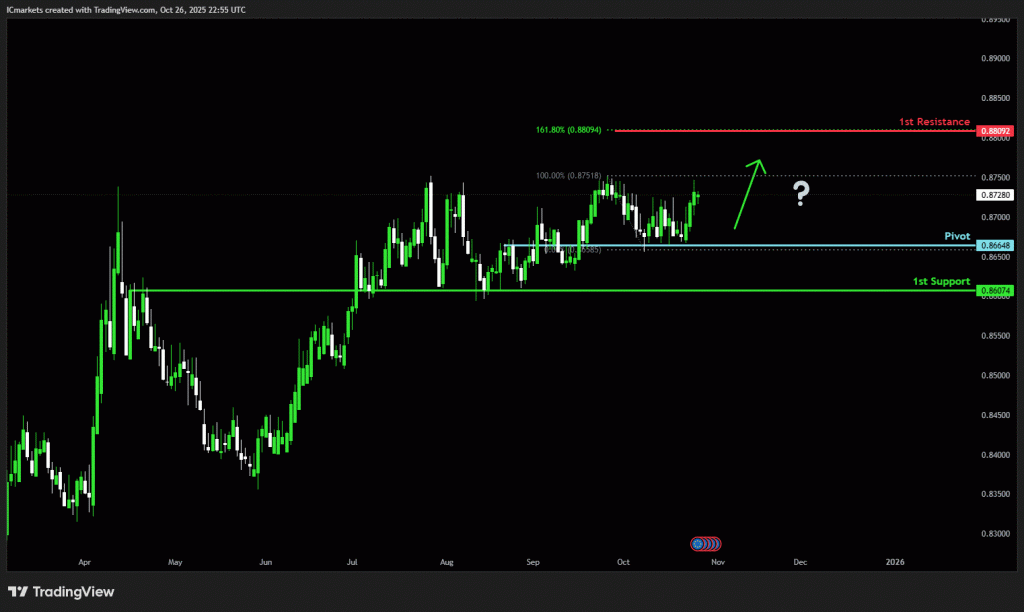
EUR/JPY:
Potential Direction: Bullish
Overall momentum of the chart: Bullish
The price has already bounced off the pivot and may continue its bullish move toward the 1st resistance
Pivot: 175.06
Supporting reasons: Identified as an overlap support, where renewed buying pressure could emerge to push the price higher.
1st support: 170.43
Supporting reasons: Identified as a swing low support, indicating a potential area where the price could again stabilize.
1st resistance: 179.83
Supporting reasons: Identified as a resistance that is supported by the 161.8% Fibonacci extension, indicating a potential level that could cap further upward movement.

EUR/GBP:
Potential Direction: Bullish
Overall momentum of the chart: Bullish
The price has already bounced off the pivot and may continue its bullish move toward the 1st resistance
Pivot: 0.8664
Supporting reasons: Identified as an overlap support, where renewed buying pressure could emerge to push the price higher.
1st support: 0.8607
Supporting reasons: Identified as an overlap support, indicating a potential area where the price could stabilize once more.
1st resistance: 0.8809
Supporting reasons: Identified as a resistance that is supported by the 161.8% Fibonacci extension, indicating a potential level that could cap further upward movement.

GBP/USD:
Potential Direction: Bearish
Overall momentum of the chart: Bullish
The price has already reacted off the pivot and may continue its bearish move toward the 1st support
Pivot: 1.3493
Supporting reasons: Identified as an overlap resistance that aligns closely with the 61.8% Fibonacci retracement, where selling pressures could intensify and potentially cap any upward retracement
1st support: 1.3036
Supporting reasons: Identified as a pullback support that aligns closely with the 100% Fibonacci projection, indicating a potential area where the price could stabilize once more.
1st resistance: 1.3740
Supporting reasons: Identified as a swing high resistance, indicating a potential level that could halt further upward movement.

GBP/JPY:
Potential Direction: Bullish
Overall momentum of the chart: Bullish
The price could make a short-term pullback toward the pivot before rising again toward the 1st resistance
Pivot: 198.28
Supporting reasons: Identified as a pullback support, where renewed buying pressure could emerge to push the price higher.
1st support: 194.84
Supporting reasons: Identified as an overlap support, indicating a potential level where the price could stabilize once more.
1st resistance: 205.33
Supporting reasons: Identified as an overlap resistance, indicating a potential level that could halt further upward movement.
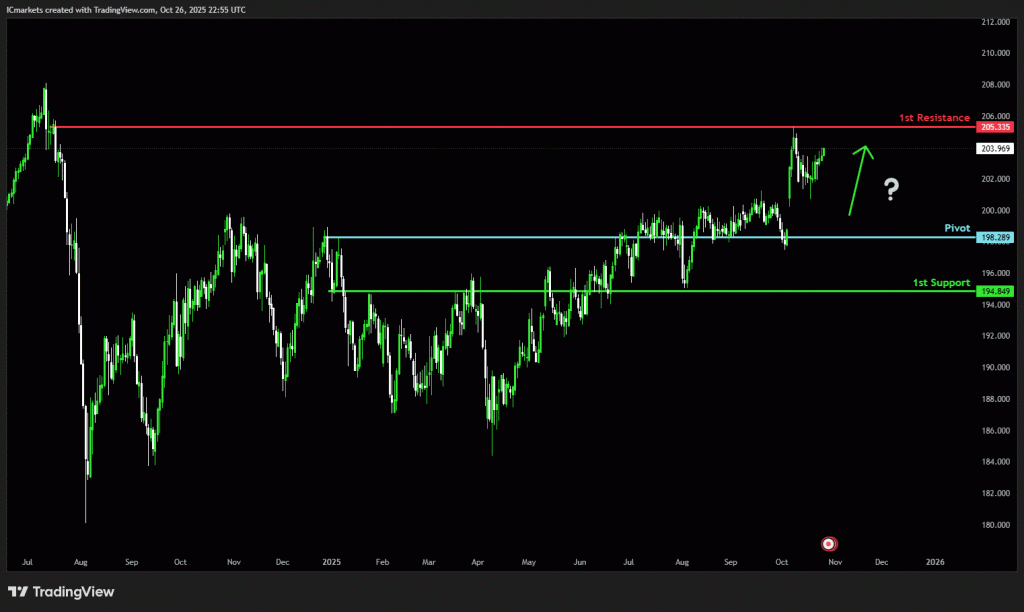
USD/CHF:
Potential Direction: Bearish
Overall momentum of the chart: Bearish
The price could see a short-term pullback toward the pivot before continuing its bearish move down toward the 1st support.
Pivot: 0.7996
Supporting reasons: Identified as a pullback resistance that aligns with the 61.8% Fibonacci retracement, where selling pressures could intensify and potentially cap any upward retracement.
1st support: 0.7864
Supporting reasons: Identified as a swing low support, indicating a potential level where the price could stabilize once again.
1st resistance: 0.8088
Supporting reasons: Identified as an overlap resistance, indicating a potential level that could cap further upward movement.
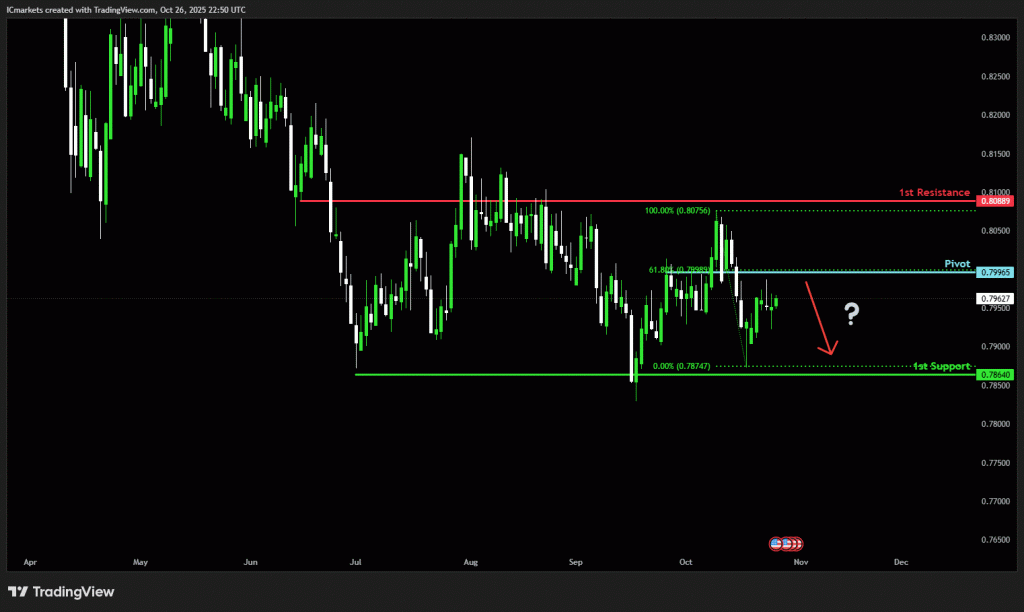
USD/JPY:
Potential Direction: Bullish
Overall momentum of the chart: Bullish
The price has already bounced off the pivot and may continue its bullish move toward the 1st resistance
Pivot: 149.69
Supporting reasons: Identified as an overlap support, where renewed buying pressure could emerge to push the price higher.
1st support: 146.58
Supporting reasons: Identified as an overlap support, indicating a strong area where buyers might return, and the price could stabilize once again.
1st resistance: 156.29
Supporting reasons: Identified as an overlap resistance. This level represents the next key area where upward movement could be capped amid increased selling pressure

USD/CAD:
Potential Direction: Bullish
Overall momentum of the chart: Bearish
The price could fall toward the pivot and make a bullish bounce off toward the 1st resistance.
Pivot: 1.3908
Supporting reasons: Identified an overlap support that aligns with the 50% Fibonacci retracement, indicating a potential area where buying interest could pick up.
1st support: 1.3742
Supporting reasons: Identified as an overlap support, indicating a key level where the price could stabilize once more.
1st resistance: 1.4166
Supporting reasons: Identified as a pullback resistance that aligns with the 61.8% Fibonacci retracement, making it a possible target for bullish advances and a level where some sellers could return to cap gains
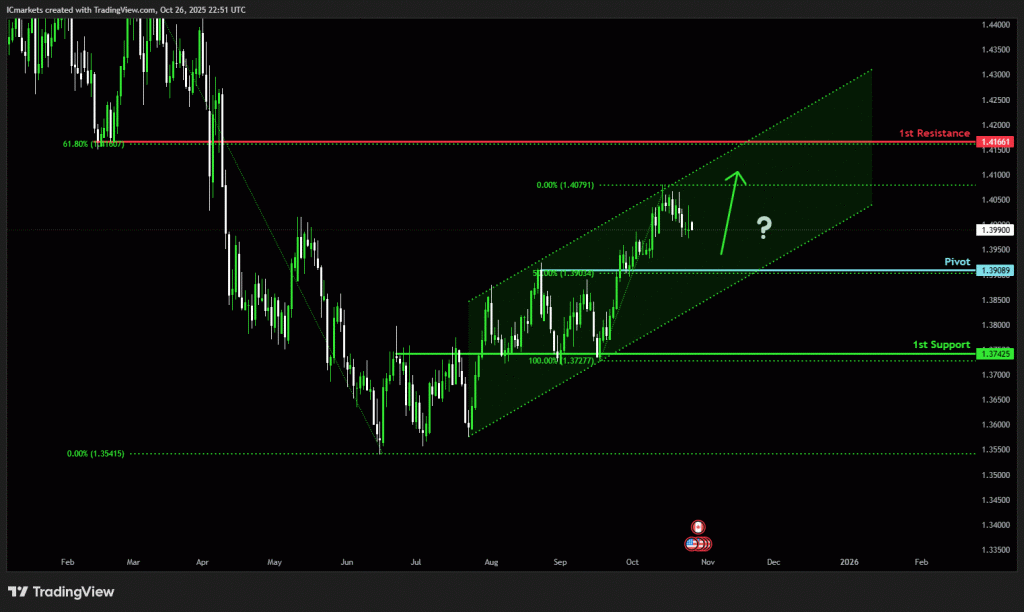
AUD/USD:
Potential Direction: Bearish
Overall momentum of the chart: Bullish
The price could see a short-term pullback toward the pivot before continuing its bearish move down toward the 1st support.
Pivot: 0.6532
Supporting reasons: Identified as a pullback resistance, where selling pressures could intensify and potentially cap any upward retracement.
1st support: 0.6400
Supporting reasons: Identified as an overlap support, this area has provided strong support historically and may attract buying interest for a potential short-term bounce
1st resistance: 0.6625
Supporting reasons: Identified as an overlap resistance, indicating a potential area that could halt any further upward movement.

NZD/USD
Potential Direction: Bearish
Overall momentum of the chart: Bullish
The price could see a short-term pullback toward the pivot before continuing its bearish move down toward the 1st support.
Pivot: 0.5853
Supporting reasons: Identified as a pullback resistance, where selling pressures could intensify and potentially cap any upward retracement.
1st support: 0.5671
Supporting reasons: Identified as a pullback support that aligns with the 161.8% Fibonacci extension, this area has provided strong support historically and may attract buying interest for a potential short-term bounce
1st resistance: 0.5988
Supporting reasons: Identified as an overlap resistance, indicating a potential area that could halt any further upward movement.
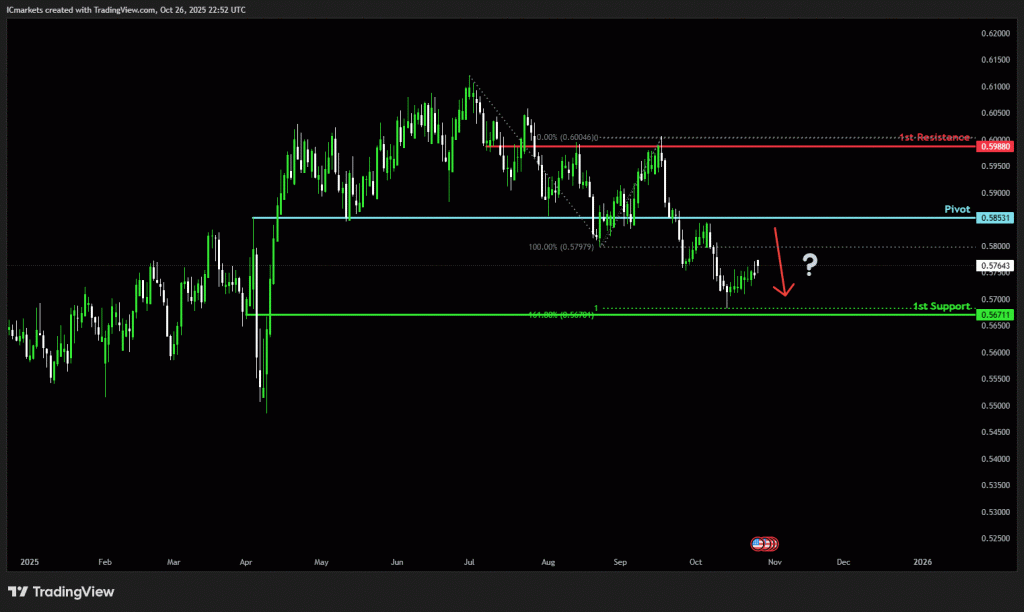
US30 (DJIA):
Potential Direction: Bullish
Overall momentum of the chart: Bullish
The price has already bounced off the pivot and may continue its bullish move toward the 1st resistance
Pivot: 45,020.36
Supporting reasons: Identified as an overlap support, where renewed buying pressure could emerge to push the price higher.
1st support: 42,889.86
Supporting reasons: Identified as a pullback support, suggesting a potential area where the price could stabilize once again.
1st resistance: 50,310.42
Supporting reasons: Identified as a resistance that is supported by the 161.8% Fibonacci extension, indicating a potential area that could halt any further upward movement.

DE40 (DAX):
Potential Direction: Bullish
Overall momentum of the chart: Bullish
The price has already bounced off the pivot and may continue its bullish move toward the 1st resistance
Pivot: 23,712.00
Supporting reasons: Identified as an overlap support that aligns with the 61.8% Fibonacci retracement, where renewed buying pressure could emerge to push the price higher.
1st support: 23,063.17
Supporting reasons: Identified as a swing low support, indicating a key level where the price could stabilize once more.
1st resistance: 24,624.84
Supporting reasons: Identified as a swing high resistance, indicating a potential area that could halt any further upward movement.
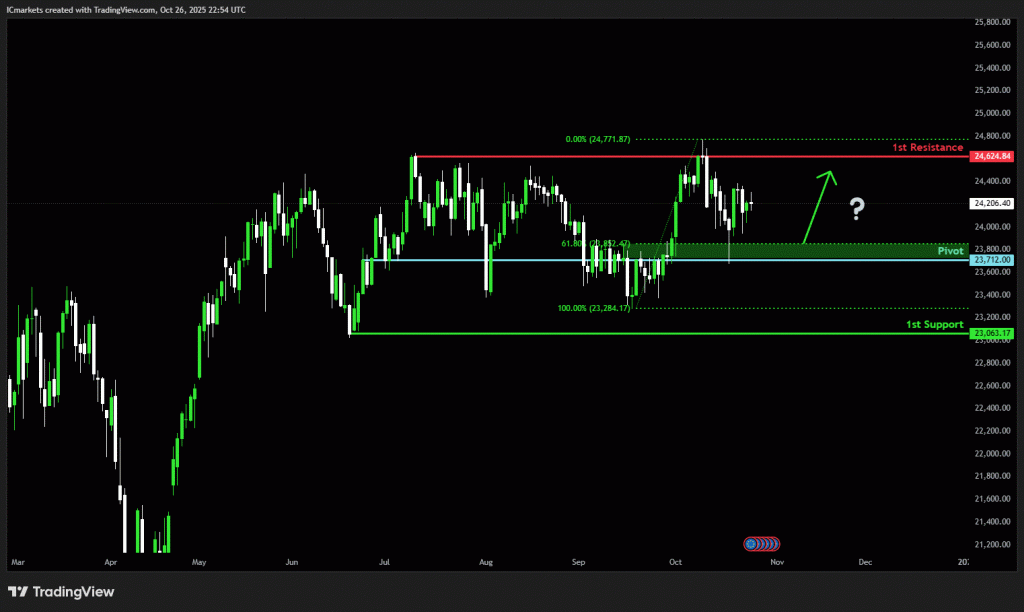
US500 (S&P 500):
Potential Direction: Bullish
Overall momentum of the chart: Bullish
The price has already bounced off the pivot and may continue its bullish move toward the 1st resistance
Pivot: 6,505.98
Supporting reasons: Identified as an overlap support, where renewed buying pressure could emerge to push the price higher.
1st support: 6,141.15
Supporting reasons: Identified as a pullback support, indicating a potential level where the price could stabilize once again.
1st resistance: 6,978.39
Supporting reasons: Identified as a resistance that is supported by the 161.8% Fibonacci extension, indicating a potential area that could halt any further upward movement.
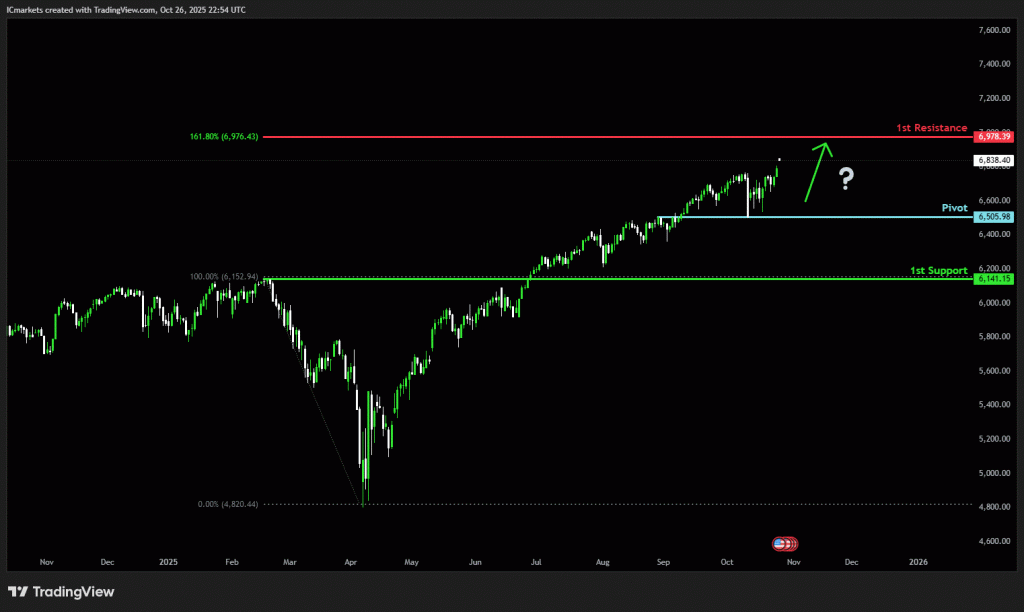
BTC/USD (Bitcoin):
Potential Direction: Bearish
Overall momentum of the chart: Bullish
The price could see a short-term pullback toward the pivot before continuing its bearish move down toward the 1st support.
Pivot: 117,390.12
Supporting reasons: Identified as a pullback resistance that aligns with the 61.8% Fibonacci retracement,, where selling pressures could intensify and potentially cap any upward retracement.
1st support: 98,137.35
Supporting reasons: Identified as a pullback support that aligns with the 50% Fibonacci retracement, indicating a potential level where the price could stabilize once more.
1st resistance: 125,853.86
Supporting reasons: Identified as a swing high resistance, indicating a potential area that could halt any further upward movement.

ETH/USD (Ethereum):
Potential Direction: Bearish
Overall momentum of the chart: Bullish
The price could see a short-term pullback toward the pivot before continuing its bearish move down toward the 1st support.
Pivot: 4,232.33
Supporting reasons: Identified as a pullback resistance that aligns with the 50% Fibonacci retracement, where selling pressures could intensify and potentially cap any upward retracement.
1st support: 3,676.47
Supporting reasons: Identified as an overlap support, indicating a potential level where the price could stabilize once more.
1st resistance: 4,846.95
Supporting reasons: Identified as a swing high resistance, indicating a potential area that could halt any further upward movement.
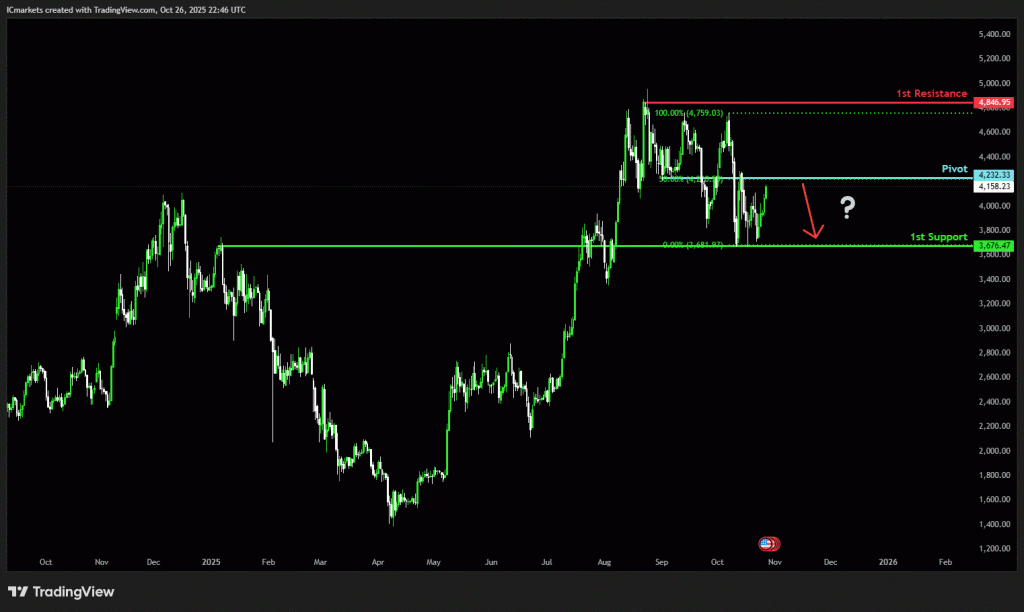
WTI/USD (Oil):
Potential Direction: Bullish
Overall momentum of the chart: Bullish
The price could make a short-term pullback toward the pivot before rising again toward the 1st resistance
Pivot: 60.16
Supporting reasons: Identified as a pullback support, where renewed buying pressure could emerge to push the price higher.
1st support: 54.92
Supporting reasons: Identified as a swing low support, indicating a key level where the price could stabilize once more.
1st resistance: 65.95
Supporting reasons: Identified as an overlap resistance, indicating a potential area that could halt any further upward movement.
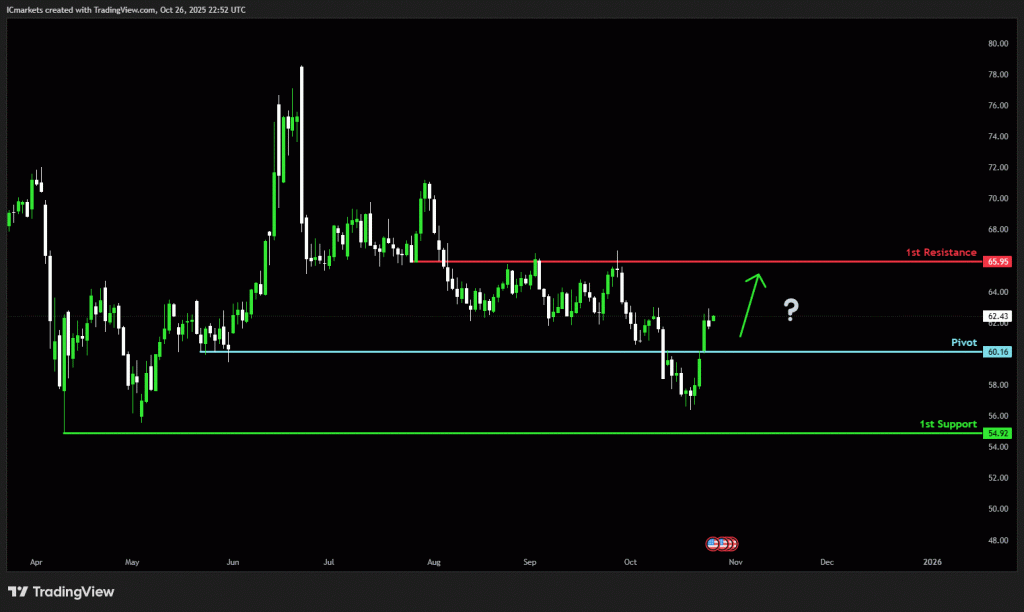
XAU/USD (GOLD):
Potential Direction: Bearish
Overall momentum of the chart: Bullish
The price could see a short-term pullback toward the pivot before continuing its bearish move down toward the 1st support.
Pivot: 4,220.06
Supporting reasons: Identified as a pullback resistance that aligns with the 50% Fibonacci retracement, where selling pressures could intensify and potentially cap any upward retracement.
1st support: 3,873.12
Supporting reasons: Identified as a pullback support that aligns closely with the 50% Fibonacci retracement, indicating a key level where the price could stabilize once more.
1st resistance: 4,379.38
Supporting reasons: Identified as a swing resistance, indicating a potential area that could halt any further upward movement.

The accuracy, completeness and timeliness of the information contained on this site cannot be guaranteed. IC Markets does not warranty, guarantee or make any representations, or assume any liability regarding financial results based on the use of the information in the site.
News, views, opinions, recommendations and other information obtained from sources outside of www.icmarkets.com, used in this site are believed to be reliable, but we cannot guarantee their accuracy or completeness. All such information is subject to change at any time without notice. IC Markets assumes no responsibility for the content of any linked site.
The fact that such links may exist does not indicate approval or endorsement of any material contained on any linked site. IC Markets is not liable for any harm caused by the transmission, through accessing the services or information on this site, of a computer virus, or other computer code or programming device that might be used to access, delete, damage, disable, disrupt or otherwise impede in any manner, the operation of the site or of any user’s software, hardware, data or property.
The post Monday 27th October 2025: Technical Outlook and Review first appeared on IC Markets | Official Blog.




